






Village of Sleepy Hollow
28 Beekman Avenue, Sleepy Hollow, NY 10591

Prepared by:
SLR Engineering, Landscape Architecture, and Land Surveying, P.C.
231 Main Street, Suite 102, New Paltz, New York, 12561
SLR Project No.: 141.21821.00001
May 31, 2024




Sleepy Hollow Downtown Marketing Committee
Mayor Martin Rutyna
Anthony Giaccio, Village Administrator
Diana Loja, Community Liaison
Patrick Sheeran, Village Trustee and Sleepy Hollow Business Owner
Lucia Ballas-Traynor, President, Sleepy Hollow Tarrytown Chamber of Commerce
Doug Lieb, Sleepy Hollow Resident
René León, Sleepy Hollow Resident and Business Owner
Consultant Team
SLR Consulting
Volt & Clove
Developed with funding assistance from Housing Trust Fund Corporation and NYS Homes and Community Renewal. Document is the property of Housing Trust Fund Corporation and the Village of Sleepy Hollow.


Appendix
Appendix

The Downtown Sleepy Hollow Marketing Study is the culmination of a three-month planning and merchant support effort conducted by the Sleepy Hollow Downtown Marketing Committee, the SLR Consultant Team, and Sleepy Hollow business owners. The goals of this effort were: to understand business owner challenges; provide direct business owner support; complete a comprehensive assessment of Sleepy Hollow’s downtown, including land use, physical conditions, business inventory, vacancy inventory, and market analysis; and to identify recommendations for the Village, business owners, and other stakeholders to enhance downtown Sleepy Hollow, reduce retail vacancies, attract new customers, attract investment, and promote sustainable growth in downtown Sleepy Hollow.
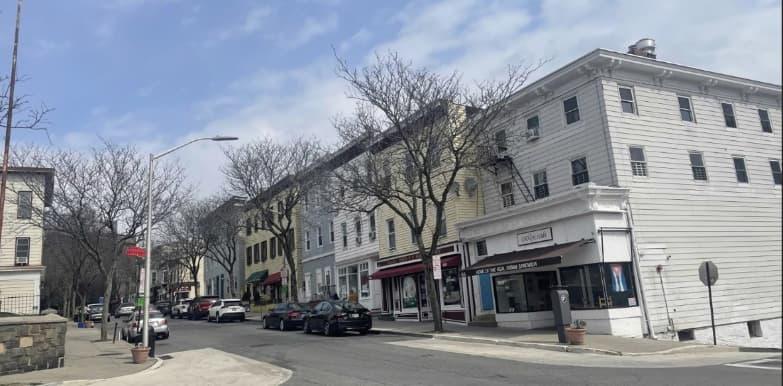
The backbone of Sleepy Hollow’s downtown is its small business community, supported by loyal local customers, and dedicated public servants. Like many small business owners, Sleepy Hollow’s business owners face challenges of rising cost of materials, high rent, and attracting new customers with a limited marketing budget. Throughout the study, business owners provided their perspectives on their challenges and ideas for downtown. Business owners also participated in two free marketing workshops that provided guidance and tools to refine their marketing strategies, gain publicity for their businesses, and run effective and low-cost marketing campaigns. Business owners’ individual marketing efforts can be supported by the Village through placemaking, quality of life improvements, infrastructure investments, improved communication and access to Village resources, and coordinated efforts to attract investment and reduce downtown vacancies.
As Sleepy Hollow prepares for future challenges and opportunities, such as the new residential population at the Edge-on-Hudson development, and State funding such as NY Forward, it will be essential to support its existing business owners and empower them to thrive. The stakeholder outreach and marketing workshops conducted during this study have already made progress toward certain goals, such as improving communication and trust between the Village and business owners, increasing capacity to implement future marketing and planning efforts, and providing direct support to business owners to improve their marketing strategies. The findings of this document should guide Sleepy Hollow’s continued efforts to enhance its downtown and direct investment toward effective solutions.


This section outlines the physical, demographic, and market conditions of the study area (see Figure 1, Study Area). A comprehensive understanding of current conditions is required to develop effective strategies that will support local businesses, reduce vacancies, and attract new customers to the study area. The information in this report was gathered through both field and online research. SLR conducted a field visit on March 20, 2024, during which staff documented business names and locations, physical conditions, land use, and vacancies. Esri ArcGIS Business Analyst is the main source for online demographic and market information.
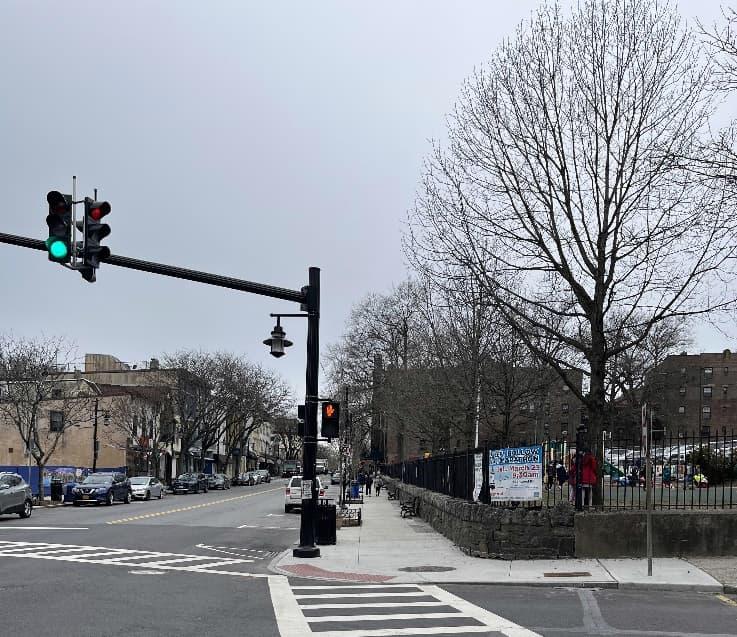
The Village of Sleepy Hollow is an incorporated village in the Town of Mount Pleasant in Westchester County, NewYork. The Village is bounded on the north and the east by the unincorporated areas of the Town of Mount Pleasant, on the south by the Village of Tarrytown, and on the west by the Hudson River. The study area is in the southern portion of Sleepy Hollow and is defined by the target corridors of Beekman Avenue (between Cortlandt Street and North Washington Street/Valley Street), Cortlandt Street, and Valley Street, and includes all tax lots that abut these corridors (see Figure 1, Study Area). Beekman Avenue is Sleepy Hollow’s primary downtown commercial area, providing residents and visitors a pedestrian-friendlydowntown experience. The Cortlandt Street and Valley Street commercial corridors host many of Sleepy Hollow’s thriving Latino-owned restaurants and small businesses, showcasing the Village’s cultural diversity. The study area is walkable from the Metro-North Railroad Tarrytown Station and the Hudson River (see Figure 2, Project Location).
The Village of Sleepy Hollow adopted its Comprehensive Plan in 2019, with the vision of a Village that “works to create a vibrant downtown with improved connections to neighborhoods, train stations, and the waterfront” and “values its cultural and socioeconomic diversity and is committed to ensuring a more inclusive future for everyone in the Village.”1 To achieve this vision, the Village plans to create a local business environment that attracts investment to Sleepy Hollow and makes the Village’s commercial areas a stronger asset for residents and visitors. The Comprehensive Plan recommends that the Village “strengthen the unique identity of Sleepy Hollow’s retail areas,” “reduce the number and impact of retail vacancies,” “improve the quality and variety of the retail and restaurant mix in and around the downtown,” and “conduct a retail market assessment to
1 Village of Sleepy Hollow Comprehensive Plan, Adopted November 26, 2019




identify the demand for particular types of retail, and strategies to attract tenants to downtown.” The Comprehensive Plan also recommends zoning revisions and improved connectivity to encourage entrepreneurship, contextual development in downtown commercial areas, and wayfinding that promotes local businesses and attractions.
In 2019, the Village of Sleepy Hollow drafted an update to their adopted 1997 Local Waterfront Revitalization Program (LWRP). The proposed LWRP promotes economic development and revitalization of the Village’s waterfront while assuring protection of its coastal resources. Because the entire Village of Sleepy Hollow is located within the coastal area boundary, all LWRP policies are applicable Village-wide. One LWRP project prioritizes the revitalization of the Inner Village (Beekman Avenue, Valley, and Cortlandt Streets Commercial Districts) by redeveloping key sites and implementing streetscape and building façade improvements to improve safety and accessibility, support beautification efforts in the Inner Village, and increase customer traffic to local businesses.
The study area offers a mix of land uses typical for a downtown (see Figure 3, Study Area Land Use). Residential uses, including one- to three-family residences and multifamily apartments are the most common land use. Apartments (multifamily) make up 30.7 percent of the 22.3-acre study area acreage, and one-to-three family residences comprise 14.7 percent. Mixed use buildings, including downtown row-type buildings2 and multifamily apartment buildings with ground floor retail are the second most common land use, comprising 28.5 percent of study area acreage. Community services comprise 16.3 percent of the study area, and include several places of worship, WL Morse Elementary School, and the Salvation Army Tarrytown Corps Community Center. Five percent of the study area’s acreage is vacant land (1.22 acres), of which 0.54 acres (2.4 percent of study area acreage) is used informally for parking.3 Approximately 3.6 percent of the study area acreage is commercial. Recreation and entertainment uses, which include Reverend Sykes Park and the Strand Theater (currently vacant), comprise 0.8 percent of the study area acreage (0.19 acres); industrial uses comprise 0.04 percent of study area acreage. Beekman Avenue connects the study area to the Hudson River and the Edge-on-Hudson mixeduse development to the west. South of the study area is downtown Tarrytown and the Metro-North Railroad Tarrytown Station, and, to the east, Sleepy Hollow Middle School and High School. To the north, Broadway/Route 9 connects the study area to the Route 9 commercial corridor, as well as key tourist destinations such as the Headless Horseman Statue, Philipsburg Manor, Old Dutch Church and Burying Ground, and Sleepy Hollow Cemetery.
2 NYS Property type classification codes defines “downtown row-type” as: “usually a two- or three-story older structure with retail sales/services on the first floor and offices and/or apartments on the upper floors; little or no onsite parking. https://www.tax.ny.gov/research/property/assess/manuals/prclas.htm
3 Vacant land includes both residential and commercial lots within the study area. Land use data is sourced from Westchester County and verified by SLR field work conducted in March 2024.

The following section describes the physical conditions and pedestrian experience within the study area starting from the Metro-North Railroad Tarrytown Station. Though outside the study area, the train station is essential to consider, as it provides an opportunity for Sleepy Hollow to capture a large consumer market of tourists and out-of-town visitors from New York City and the Hudson Valley area. Creating and fostering an attractive and welcoming pedestrian route from the train will be important for attracting visitors with spending potential to the study area. The section below describes the physical aspects of the study area that may deter or attract pedestrians. (See Appendix A for physical conditions photographs.)
The Metro-North Railroad Tarrytown Station is located approximately one-quarter mile south of the study area; an approximately six-minute walk north along Depot Plaza/Cortlandt Street to the southern edge of the study area (see Figure 2, Project Location). Upon exiting the train station, pedestrians destined for Sleepy Hollow head north along Depot Plaza and encounter a difficult intersection at Main Street / Cortlandt Street / Depot Plaza. The long east/west crosswalk at this location requires pedestrians to traverse five lanes of traffic. As the primary walking route from the train station to Sleepy Hollow, this location is an integral destination decision point for pedestrians.
To the east of the train station, trees line both sides of Main Street in Tarrytown, making it an attractive walk. Similarly, trees line the east side of Cortlandt Street to the intersection with Sarah Michael’s Park. However, the west side of Cortlandt Street features the Railroad Avenue street ramp and a chain-link fence with green privacy screen that do not create a welcoming pedestrian environment. North of Sarah Michael's Park, the east side of Cortlandt Street is developed primarily by the Tarrytown Station Center, a strip shopping center with a large parking lot along the street frontage and a McDonald’s. The sidewalks along the western fenced side of Cortlandt Street are narrow, and the lighting features are not at pedestrian scale.
Upon arrival at the Wildey and Cortlandt Street intersection, pedestrians enter the study area. The east/west crosswalk at Division and Cortlandt Streets traverses four lanes of vehicular traffic, with a narrow pedestrian refuge in the center median. The portion of the crosswalk across Cortlandt Street extends diagonally from the median to the sidewalk, which creates a longer crossing. Land uses at the corners of Division/Cortlandt and Wildey Streets are a McDonald’s (southeast corner), a basketball court at Reverend Sykes Park (northeast corner), a wholesale bakery (southwest corner), and an autobody shop (northwest corner). Except for the basketball court, the uses at this intersection are auto centric with significant vehicle ingress and egress. This intersection’s vehicle-centric character is worsened by the absence of trees, landscaping, and pedestrian-scale amenities.
As noted, Cortlandt Street between Wildey Street and College Avenue (see Figure 1, Study Area) is the first block of the study area that pedestrians headed north from the Tarrytown Station would experience. The southern end of Cortlandt Street (at Wildey Street) is developed with an autobody shop on the west side and a basketball court (surrounded by a chain link fence) on the east side. North of the basketball court, the east side of the block is entirely occupied by the 100

College Avenue apartments and the building’s accessory parking lot. North of the autobody shop on the west side of Cortlandt Street, a few ground-floor businesses create street-level activity. The façades of these buildings are generally in good condition; however, maintenance, cleaning, and repair (the shutters on the windows above 89Cortlandt Street are broken, see Photo 1) would improve the pedestrian/visitor experience. The street signs are decorative, with Sleepy Hollow branding. There are benches and trashcans along the sidewalk, and there are several wellestablished street trees. The businesses’ signage varies in condition. Several of the businesses’ signs are located on their awnings, others are building mounted. The sign for 97 Cortlandt Street should be updated with the current business name (see Photo 2), and Gladys Market at 87 Cortlandt Street has no business sign (see Photo 3).
Cortlandt Street between Cedar Street/College Avenue and Depeyster Street is developed on both sides with buildings that offer the potential for ground-floor businesses, however, many are currently vacant. The Union Hose Fire House is at the northwest corner of Cedar/Cortlandt Streets, adjacent to the Rock of Salvation Church and its parking lot. Further north along the west side of Cortlandt Street is a long brick building with two vacant storefronts and an autobody shop (see Photo 5).
On the east side of Cortlandt Street, at the intersection of Cortlandt Street and College Avenue, the building façade of 128 Cortlandt Street is crumbling and in need of cleaning and repair (see Photo 4). The east side of Cortland Street on this block has a consistent architectural style, with mainly three-story multifamily residential or mixed-use buildings without driveways, creating a pedestrian-friendly environment. The ground floor exterior of 134 Cortlandt Street was recently renovated, and the interior is currently being renovated (see Photo 6). A few residential buildings on this block need façade maintenance. At 154 Cortlandt Street, is a standalone, one-story building with a small fenced-in side lot that is incongruent with the density and character of the block (see Photos 7 and 8). The awnings on this block need cleaning, especially the awning for 160 Cortlandt Street (see Photo 9).
Street lighting is limited, resulting in nighttime pedestrian safety concerns, which are exacerbated by the building vacancies on this block. However, the intersection of Cortlandt and Depeyster Streets is pedestrian friendly with shorter crosswalks and painted curb extensions (see Photo 10).
The southwest and southeast corners of this stretch of Cortlandt Street are occupied by St. Teresa’s School (currently listed online as temporarily closed) and Croqueteria, a Cuban restaurant. Well established trees line both sides of the street with active ground-floor businesses (no vacancies) throughout. Building façades require maintenance, painting, and signage upgrades, including creating consistency in business signage (awning or building mounted), would enhance the pedestrian experience. The church building at 177 Cortlandt Street, the former Holy Cross Church, which is currently vacant, provides architectural interest that could be augmented with façade maintenance and door repair (see Photo 11). Additional decorative, pedestrian-scaled lighting would make this a more attractive pedestrian route at night.

North of Chestnut Street, Cortlandt Street connects to Beekman Avenue, Sleepy Hollow’s primary commercial corridor. Most of the business façades on this stretch of Cortlandt require some maintenance/cleaning but have attractive window displays and clear signage. The building at 185 Cortlandt Street has peeling paint (see Photo 12). Two ground-floor businesses are currently vacant—110 Beekman Avenue and 194 CortlandtStreet.A public outdoor seatingarea with picnic tables, string lights, and planters is located at the southwest corner of Cortlandt Street, where it intersects with Beekman Avenue (see Photo 13).
Beekman Avenue is the main commercial corridor in Sleepy Hollow. At the northwest end of the study area, 95 Beekman Avenue has scaffolding set up for building repairs (see Photo 14). This brick building fills an entire block on the north side of Beekman Avenue and houses a range of ground-floor businesses below five stories of apartments. While there is consistency in façade treatments (i.e., all the awnings are the same color, with similar lettering), maintenance/cleaning is required. The WL Morse Elementary School playground is located east of/adjacent to 95 Beekman Avenue and occupies the entire block frontage on the north side of Beekman Avenue from Pocantico Street to North Washington Street.
The south side of Beekman Avenue, opposite the Morse School, offers a range of building façade designs that add to the diverse architectural character of Beekman Avenue, but many of the buildings require façade cleaning. Business signage is generally mounted on the building or awning; however, the business at 90 Beekman Avenue has no signage (see Photo 15). Several storefronts on this strip are vacant, including 72 and 74 Beekman Avenue, and windows are boarded up, which makes the main commercial corridor feel inactive (see Photo 16 and 17). The historic Strand Theatre (80 Beekman Avenue) is also currently vacant but has a sign suggesting it will be redeveloped as a visitor and performance center (see Photo 18). There is a large vacant lot at 64-68 Beekman Avenue that has been empty for over 15 years; it is blocked by a fence that has a Sleepy Hollow banner on it (see Photo 19).
A curvy stretch of North Washington Street runs north-south, connecting Beekman Avenue to Valley Street. A lack of directional signage on Beekman Avenue facing south inhibits awareness of the abundance of restaurants and small businesses on Valley Street. The streetscape along North Washington Street is uninviting due to several windowless facades, driveways breaking up the sidewalks, lack of street trees, and mostly non-retail use, especially on the west side of the street. Building façade cleaning and maintenance is required, especially the Sleepy Hollow Laundromat at 205 Valley Street (see Photo 20). The Riverside Events studio at 228 North Washington Street has a beautiful mural painted on the south side of the building, however, the mural is not visible when looking south from Beekman Avenue (see Photo 21). There are four pedestrian crosswalks at the intersection of North Washington and Valley Streets that all connect to a pedestrian island. Pedestrians walking on the east side of the North Washington Street

heading to Valley Street must traverse the widest part of the intersection, crossing North Washington Street, the pedestrian island, and Valley Street. The pedestrian island at the intersection of North Washington and Valley Streets has some trees and benches but lacks wayfinding signage to direct people to the shopping plazas on Valley Street (see Photo 22).
Valley Street is home to many of Sleepy Hollow’s Latino businesses. There are string lights hung over the street between two shopping centers, and a tile mosaic on the side of 185 Valley Street is visible when walking towards Valley Street from North Washington Street. All these amenities create a welcoming destination (see Photo 23). Valley Street also provides a scenic vista where pedestrians can see the Governor Mario M. Cuomo Bridge in the distance. The two shopping plazas across from each other—Sleepy Hollow Plaza on the east side and 185 Valley Plaza on the west side—have mismatched design aesthetics. The façades of these shopping centers are well maintained, but the designs create a non-cohesive sense of place (see Photos 24 and 25). The Sleepy Hollow Plaza has decorative fencing between the sidewalk and the plaza’s restaurants and storefronts that adds unique character to the streetscape. In addition to the two plazas, there are a few more ground floor businesses along Valley Street, but most of the remainder of Valley Street is a mix of single- and multi-family residential buildings. The building façade of the Life Center Immigration Legal Services at 174 Valley Street, requires maintenance and repair of cracks and discoloration (see Photo 26). While Valley Street is improved with street trees and plantings, additional streetscape amenities would enhance the pedestrian experience and make this shopping area feel more established.
Valley Street between College Avenue and Wildey Street consists of several large, 9-10 story affordable residential apartment buildings, including Margotta Court which is managed by the North Tarrytown Housing Authority, and the Smith White Senior Residence (low-income senior housing) on the east side of the street, and the 100 College Avenue complex (privately owned low-income housing)on the west side.South of theSmith White Senior residence isa large vacant lot owned by and adjacent to the Salvation Army Tarrytown Corps Community Center, which is located on the northeast corner of the intersection of Valley Street and Wildey.
The presence of vacant storefronts in the study area contributes to an unwelcoming and disconnected atmosphere, leaving visitors with the impression of a struggling downtown lacking in a variety of goods and services. Empty storefronts not only detract from the overall aesthetic but also signal potential economic challenges. As a result, visitors may be discouraged from exploring Sleepy Hollow or returning in the future. There are currently 14 vacant commercial properties consisting of storefronts, buildings, and lots, translating to a study area vacancy rate of approximately 15 percent for commercial properties.4 Study area vacancies are concentrated on Beekman Avenue and on Cortlandt Street between College Avenue and Depeyster Street. Table 1, Vacant and Partially Vacant Commercial Properties in the Study Area, lists and describes the vacant properties. The properties identified as partially vacant are properties with
4 The commercial vacancy percentage is calculated based on the vacancies shown in Table 1 as a percentage of the both the occupied businesses and the vacant commercial spaces in the study area. There are 79 occupied businesses and 14 vacant commercial spaces, for a total of 93 commercial spaces.

multiple storefronts where at least one, but not all, storefronts are vacant. Figure 4, Study Area Commercial Vacancies, presents the location of the vacant properties. Table 2, Commercial Properties for Lease,lists available commercial properties for lease in the study area. Two vacant storefronts are listed for lease and are in both Table 1 and Table 2. There is one occupied property that is listed for lease.
164-68 Beekman AvenueVacant lot, has been vacant for over 15 years.
272 Beekman Avenue
Two vacant storefronts.
174 Beekman Avenue Vacant and undergoing renovations.
180 Beekman Avenue
2115 Cortlandt Street
The historic Strand Theatre, most recently the Open Door Medical Center, is now closed. Sign on property states it is being developed into a visitor and performing arts center.
Two vacant storefronts/offices for lease.
1134 Cortlandt Street Vacant and undergoing renovations.
1144 Cortlandt Street Vacant and undergoing renovations.
2147 and 149 Cortlandt Street Vacant with no signs of renovation or for lease signs.
1* 185 Cortlandt Street D&W Magical Events currently closed with windows covered.
1* 194 Cortlandt Street Vacant with no signs of renovation or for lease signs.
1227 North Washington Street Vacant with no signs of renovation or for lease signs.
Total: 14
Note: * indicates partial vacancy. Denotes properties with multiple storefronts where at least one, but not all, storefronts are vacant
Sources: Loopnet, Century 21 Commercial; Listings as of

The study area includes 79 storefront businesses, distributed across various sectors (see Figure 5, Business Mix). Twenty-two percent of businesses in the area are eating and drinking establishments, including full-service and quick-service restaurants, bars, and nutrition/juice shops. Delis, markets, bakeries, and other grocery-related stores make up 18 percent of the businesses in the study area. The third-largest business category, comprising 16 percent, is barbershops and salons; there are 13 barber shops and hair salons within the study area. Retail goods stores in the study area include four electronic shops, three variety stores, one furniture shop, one book shop, one florist, and one gift shop; these retail goods stores comprise 13 percent of business in the study area. Excluding barbershops and hair salons, 15 percent of businesses in the study area provide retail services. The retail service businesses include four check-cashing stores, three laundromats, two tailors, one bike repair shop, one mechanic, and one car wash. Non-retail businesses constitute 15 percent of businesses in the study area, including five professional services offices, two social services offices, two dentists, one bank, one financial services office, and one travel agency. There is also one industrial business, a welding shop, and one event venue. A full inventory of businesses in the study area can be found in Appendix B.
The study area’s business mix is predominately catered toward convenience shopping, due to the high number of businesses that provide neighborhood services such as barbershops, delis, laundromats, and convenience stores. The retail shopping options in the study area are generally low price-point retail, such as variety stores and thrift stores. Convenience shopping districts serve the important function of meeting residents’ needs. Conversely, destination businesses are those that attract consumers from surrounding communities that want a unique shopping or entertainment experience. Destination businesses include specialty boutiques, workout studios, furniture and home furnishings stores, and movie or performance theaters. Retail shops that have higher price points can also attract consumers with more disposable income and increase consumer spending potential. Sleepy Hollow may consider targeting destination businesses to the downtown to fill vacancies and attract customers from the broader region.
Due to the prevalence of online shopping, brick and mortar businesses must provide a unique instore experience to their customers or offer a service that cannot be delivered. Because of this, many downtown business districts, as is the case in Sleepy Hollow, have an abundance of restaurants, bars, and personal service businesses such as salons. However, brick and mortar retail can still be successful if stores offer a curated selection of unique local products; provide high-end products that customers prefer to shop for in person, such as jewelry, watches, or furniture; offer products that require specialized expertise; or combine experiences with retail. For example: an art supply store that offers art classes, a bookstore that holds children’s story times and author events, a pottery studio that also sells local potters’ work, or a sporting goods or athletic store that offers repairs and rentals, coordinates athlete meetups, and employs skilled experts. A charming downtown environment can help to create a destination for shoppers and enhance their shopping experience.

Eating & Dining, 22%

ure 5
Downtown Sleepy Hollow, (the study area) attracts or could attract several different types of customers such as local residents who are regular customers, including both English and Spanish-speaking customers; residents of nearby towns in Westchester County; and tourists or day-trippers from New York City and the greater Hudson Valley region. To better understand these consumer groups, SLR identified primary and secondary trade areas for the study area businesses. The primary trade area captures the residential population within a five-minute drive of the study area. The residents of the primary trade area are likely to shop in the study area on a regular basis due to proximity and convenience. The secondary trade area captures the residential population within a fifteen-minute drive of the study area. The secondary trade area residents are potential consumers that would travela short distance to the study area for a specific purpose/destination. Other important study area consumers include tourists that are drawn to the area’s historic sites and seasonal events.
The following sections describe the demographics of the primary and secondary trade areas and for each trade area, we use Esri Business Analyst Tapestry Segmentation to identify specific consumer segments within the trade areas, their spending habits, and how they are best reached by marketing. The first step in developing a marketing strategy is to identify a target customer to tailor marketing toward their unique preferences. The individual businesses in downtown Sleepy Hollow will have different target customers depending on the nature of the business. The Village can use information about consumer segments to create targeted special event marketing and to identify types of downtown businesses that would thrive in downtown Sleepy Hollow.
This analysis defines the study area’s primary trade area as a five-minute drive from the study area (see Figure 6, Primary Trade Area). Consumers that live within this primary trade area may be repeat customers that patronize study area businesses for their everyday needs and convenience purchases and those that would regularly visit study area restaurants. The primary trade area is generally bounded to the north by the Sleepy Hollow Manor residential neighborhood, to the east by the Tarrytown Reservoir, to the south by Interstate 287 in the Village of Tarrytown, and to the west by the Hudson River. The primary trade area also includes part of the Village of Tarrytown. Tarrytown’s businesses capture some of the spending potential of primary trade area residents.
The primary trade area also includes the residents of the Edge-on-Hudson development, a mixeduse, transit-oriented, riverfront community developed on the former General Motors assembly plant property. Edge-on-Hudson is approved to build 1,177 townhomes, condos, and apartments; a 140-room boutique hotel; 135,000 square feet of retail space; 35,000 square feet of office space; and approximately 16 acres of parks.5 This large development will provide businesses in the study area with a new demographic of potential customers within less than a mile’s walk.
Approximately 14,428 people live within the primary trade area. The primary trade area population has a diverse ethnic and racial makeup, with 45.9 percent Hispanic or Latino, 43.9 percent white,
5 As of April 2024, more than half of the residential units have been developed, and a DeCicco & Sons gourmet market is under construction.

So ur ce : ESRI B us ine ss Anal yst

Primary Trade Area — 5-Minute Drive Time
Study Area — Beekman Ave., Cortlandt St., and Valley St.
Primary Trade Area Figure 6
3.4 percent Asian, 3.3 percent Black or African American, and 3.2 percent two or more races. Within the Village of Sleepy Hollow, which is partially captured by the primary trade area, 50 percent of the population is Hispanic or Latino, including Dominican (19.9 percent), Ecuadorian (17.4 percent), Colombian (3.8 percent), Puerto Rican (1.2 percent), Salvadoran (1.1 percent), Mexican (1.1 percent), and all other Hispanic/Latino (5.5 percent).6
The median household income for theprimary trade area is$83,309, while the average household income is significantly higher at $126,727, suggesting wide income disparity among households in the area. This disparity is also reflected in the primary trade area education attainment levels, with approximately 38 percent of the 25-year-old and over population earning a high school degree or less and 40 percent earning a bachelor’s degree or higher. More than 50 percent of the labor force in the primary trade area is employed in the construction, health care and social assistance, educational services, retail trade, or the professional, scientific, and technical services industries.7
In 2023, households in the primary trade area reported a median after-tax household income of $70,454; thirty-seven percent of households reported more than $100,000 in disposable income.8 The Edge-on-Hudson developmentadds a new,high-income population to theprimary trade area. Sales prices for Edge-on-Hudson condos range from $500,000 to $2.9 million, and townhome sales prices range from $990,000 to $2.35 million. The rent for studio apartments starts at $3,494, and the rent for two-bedroom apartments starts at $5,300. Based on this price range, Edge-onHudson households' annual income ranges from $135,000 to $770,000.9
To understand how consumers in the primary trade spend their income, SLR used consumer expenditure data and Tapestry Segmentation from Esri Business Analyst. Tapestry Segmentation identifies consumer markets in an areaand describes their lifestyle choices and spending habits.10 Table 3, Primary Trade Area Tapestry Segmentation (Five-Minute Drive) presents the Tapestry Segment results and key demographic characteristics of primary trade area consumers. A description of the consumer markets is provided herein.
Source: Esri Business Analyst
6 U.S. Census Bureau. “Hispanic or Latino Origin by Specific Origin.” American Community Survey (ACS) 5-Year Estimates Detailed Tables, Table B03001, 2022; Ethnicities included in “all other Hispanic/Latino” individually comprise less than one percent of the Village population.
7 Collected through ArcGIS Business Analyst, which used data from US Census Bureau, 2017-2021 ACS.
8 Esri defines disposable income as after-tax household income.
9 Assumes 30 percent of gross annual household income spent on home costs; assumes a 30-year mortgage with a 6.83 percent interest rate and a 20 percent downpayment.
10 How to use and interpret Esri’s Tapestry Segmentation, Esri Data Development: https://arcg.is/1yL1OC

Diverse Convergence. The ESRI Tapestry Segmentation model identified the largest consumer segment in downtown Sleepy Hollow’s primary trade area (27.6 percent) as “Diverse Convergence.” This group includes a significant foreign-born population, with a portion that are linguistically isolated. Educational attainment is low. Households include young families with children, married couples without children, and multi-generational households. Median household income for the Diverse Convergence segment is lower than the US median. Much of this segment’s income is reserved for high housing costs, so households have less income for discretionary purchases. Less likely to own a car than the average U.S. consumer, many walk, bike, or use public transportation to get to work. Consumers access information and consume media on Spanish-language websites and television and listen to Hispanic music. Purchases are usually for their children and families’ food, clothing, and education. Personal style is also important to these consumers.
Trendsetters. The “Trendsetters” are young, well educated, and well paid. They tend to not own homes or cars, spending their income on entertainment, dining out, and hobbies. This population makes a higher median household income compared to the US median but has a much lower median net worth due to their younger age and spending habits. Trendsetters tend to spend more on education, housing, food, apparel and services, and entertainment and recreation than the national average consumer. Many Trendsetters work from home, access information online, and are active on social media. They participate in local arts and cultural activities and like to try new hobbies and experiences.
Downtown Melting Pot. The Downtown Melting Pot consumer segment shares characteristics with the “Diverse Convergence” segment but are older, with higher educational attainment, and longer work commutes. This segment has racially and ethnically diverse residents with a large foreign-born population. Households are mainly married-couple families and multigenerational households. These consumers tend to be employed in white-collar occupations and work outside the county where they reside. They spend less than the national average on housing, food, apparel, etc., but 11 percent more on education. Consumers enjoy eating at family restaurants and try to buy healthy food.
City Lights. The City Lights consumer segment is differentiated from the other segments by their above-average income, financial savvy, and commitment to social equality and the environment. Residents are racially and ethnically diverse, tend to have completed some college or have a college degree, and earn a high income in professional and service occupations. The City Lights group is willing to commute to their jobs, to budget, and to work hard to support their lifestyles. They spend more than the national average in all budget categories, spending 10 percent or more than the national average on education, housing, apparel, and services. As consumers, they are price savvy and look for deals, often shopping at warehouse clubs or salesat stores like Marshalls and Target. They are health- and environment-conscious consumers who prefer natural products and exercise regularly.
Urban Chic. The Urban Chic consumer segment is well educated and high earning—median household income is for this segment is almost double the national median. This segment spends at least 70 percent more than the national average across all spending categories, in particular education, apparel and services, housing, and entertainment and recreation. Most Urban Chic households are married couples or singles. They do their grocery shopping at Trader Joe’s, Costco, or Whole Foods Market and appreciate high-end food and drink, such as organic food, imported wine, and high-quality coffee. They shop at upscale and luxury stores and spend on

cultural experiences and media like art galleries, museums, movies, and books. They also have expensive exercise habits such as skiing, yoga, and tennis.
Table 4, Primary Trade Area Market Potential, Selected Behaviors, outlines selected consumer behaviors that the primary trade area residents are more likely than the average US adult to engage in. The below information is aggregated for the primary study area:
Table 4: Primary Trade Area Market Potential, Selected Behaviors
Notes: Market Potential Index (MPI) is a measure of consumers’ likelihood to engage in certain behaviors as compared to the national average. An MPI of 100 indicates the US average. Behaviors with an MPI above 100 are above average and indicate high demand in an area.
Sources: Esri Business Analyst; MRI-Simmons; 2023

The secondary trade area is roughly a 10-mile radius, or 15-minute drive time, from the study area (see Figure 7, Secondary Trade Area) and is bounded by Ossining Village to the north, Westchester County Route 64 to the east, the Village of Hastings-On-Hudson to the south, and Rockland County Route 23 to the west (on the west side of the Hudson River). Within this secondary trade area are commercial corridors that compete with study area businesses. Residents of the secondary trade area may be drawn to the study area for specific attractions or businesses.
The secondary trade area, which also includes the primary trade area, has a population of 120,976 residents making up roughly 43,384 households. The secondary trade area population has a lower share of Hispanic or Latino residents compared to the primary trade area, but a higher share of Black or African American and Asian populations. This trade area has high educational attainment levels, with over 50 percent of the population having a bachelor’s degree or higher. The primary and secondary trade area labor forces have the same top-five industries, but the secondary trade area features more population employed in sales or business and financial operations occupations. Compared to the primary trade area, the secondary trade area has a higher median household income of $114,787, with 27 percent of the households making $200,000 or more. The median disposable income in the secondary trade area is $100,741, which is higher than the primary trade area and, therefore, the households in the secondary trade area have higher spending potential. This disparity is also reflected in the Tapestry Segments of this secondary trade area. The two largest consumer markets in the secondary trade area have a median household income of over $100,000. Table 5, Secondary Trade Area Tapestry Segmentation (Fifteen-Minute Drive) presents the Tapestry Segment results and key demographic characteristics of secondary trade area consumers. A description of segments that were not included in the primary trade area is provided herein.
Source: Esri Business Analyst
Top Tier. Median household income for the Top Tier group is three times the US median household income, making it the wealthiest Tapestry Segment. Most households are married couples without children or with older children. Residents are highly educated professionals who have reached their career goals and earn their money from wages, salary, and investments. They spend triple the US average across all household budget categories and tend to spend at upscale retailers. This segment regularly spends on personal services such as spas and salons, dry cleaning, housekeeping, landscaping, and exclusive gyms.
Pleasantville. The Pleasantville segment is a prosperous, older consumer market with a median net worth that is more than double that of the US median. Consumers in this market tend not to be cost-conscious and value quality. Their average household spending is higher across all

STUDY AREA

So ur ce : ESRI B us ine ss Anal yst
Secondary Trade Area — 15-Minute Drive Time
Study Area — Beekman Ave., Cortlandt St., and Valley St.
VILLAGE OF SLEEPY HOLLOW DOWNTOWN MARKETING PLAN
Secondary Trade Area Figure 7
categories compared to the US average, and they often shop in a variety of stores, from upscale to discount.
Because the secondary trade area has high household incomes, its residents are above-average spenders in many categories. The selected consumer behaviors in Table 6, Secondary Trade Area Market Potential, Selected Behaviors, are those for which the secondary trade area residents exceed the national average Market Potential Index (MPI) by 10 percent or more.11
Table 6: Secondary Trade Area Market Potential, Selected Behaviors
Notes: Market Potential Index (MPI) is a measure of consumers’ likelihood to engage in certain behaviors as compared to the national average. An MPI of 100 indicates the US average. Behaviors with an MPI above 100 are above average and indicate high demand in an area.
Sources: Esri Business Analyst; MRI-Simmons; 2023
11 Market Potential Index (MPI) is a measure of consumers likelihood to engage in certain behaviors as compared to the national average. An MPI of 100 indicates the US average. Behaviors with an MPI above 100 are above average and indicate high demand.

There is a diverse mix of consumer segments within the primary trade and secondary trade areas who have varied spending habits and preferences. Residents within the primary trade area are younger, more diverse (primarily Hispanic/Latino), and have lower incomes than those in the larger secondary trade area. The largest segment within the primary trade area, Diverse Convergence, captures Sleepy Hollow’s Latino population. The second largest segment within the primary trade area is thetrendsetters. Trendsetters are young, tech savvy, and enjoy spending on experiences such as culinary, cultural, and entertainment experiences. The study area businesses currently cater primarily to the Diverse Convergence segment, as it has convenience businesses, businesses at lower price points, and many businesses are Hispanic/Latino owned and primarily serve Hispanic/Latino customers. It is important that the business district serves residents’needsand that existing businesses maintain their core customer base. Businessesmay consider strategies to attract the Trendsetters, who are above-average spenders. Trendsetters enjoy new and authentic experiences and enjoy eating out at restaurants. Sleepy Hollow’s many authentic Latino restaurants can provide an attractive experience to the Trendsetters. Target industries for Sleepy Hollow to attract the Trendsetters include arts, culture, entertainment, and fitness.
The secondary trade area has a large population with high incomes. Most of the study area businesses do not currently meet the preferences of the secondary trade area consumers. The secondary trade area’s largest segment, Urban Chic also comprises 13.2 percent of the primary trade area population and is therefore a recommended target consumer segment. Urban Chic consumers have high household incomes and enjoy specialty retail goods that are well-suited to small downtown shops, such as imported wine, high-quality coffee, and organic food. Like the Trendsetters, they also enjoy cultural experiences and exercise classes like yoga.
Businesses within the study area who wish to attract both Latino and non-Latino customers will need to have a dual-pronged marketing strategy as these two segments speak different languages and often access media through separate channels. Businesses should consider having signage and menus in both English and Spanish and hiring bilingual staff.
Both the primary and secondary trade area residents are avid readers of both digital and paper newspapers and magazines; therefore, businesses may consider reaching new customers through paid or earned publicity in local newspapers and magazines.
Primary and secondary trade area residents, though they may differ in some ways are similar in their consumer values; residents care about helping the environment and are more likely than the average US adult to pay more for environmentally safe and high-quality products. Businesses in the study area can appeal to many consumers by emphasizing quality, authenticity, local ownership, and environmentally safe products and practices.

Sleepy Hollow’s tourist destinations attract visitors from outside its primary and secondary trade areas. Because it is the setting for Washington Irving’s short story, “The Legend of Sleepy Hollow”, each autumn, Sleepy Hollow attracts visitors to experience the Headless Horseman legend and partake in events such as the Great Jack O’ Lantern Blaze, Hulda’s Night, and the Haunted Hayride. Year round, Sleepy Hollow attracts visitors to its historic sites and beautiful landscapes along the Hudson River. Visitors spend time touring the Kykuit Rockefeller Estate, Philipsburg Manor, the Sleepy Hollow Cemetery, the Sleepy Hollow Lighthouse, and enjoying a walk along the scenic Hudson Riverwalk. Only a 40-minute train ride from New York City, Sleepy Hollow attracts visitors traveling from New York City looking for a day trip or a weekend getaway. According to the 2022 Economic Impact of Visitors in New York conducted by Tourism Economics, visitors to Westchester County spent a total of $2 billion annually during their visits, which is almost double any other county in the Hudson Valley region. Out of the $2 billion, 36 percent was spent on food and beverage, 24 percent on lodging, and 19 percent on retail and service stations (gasoline).12
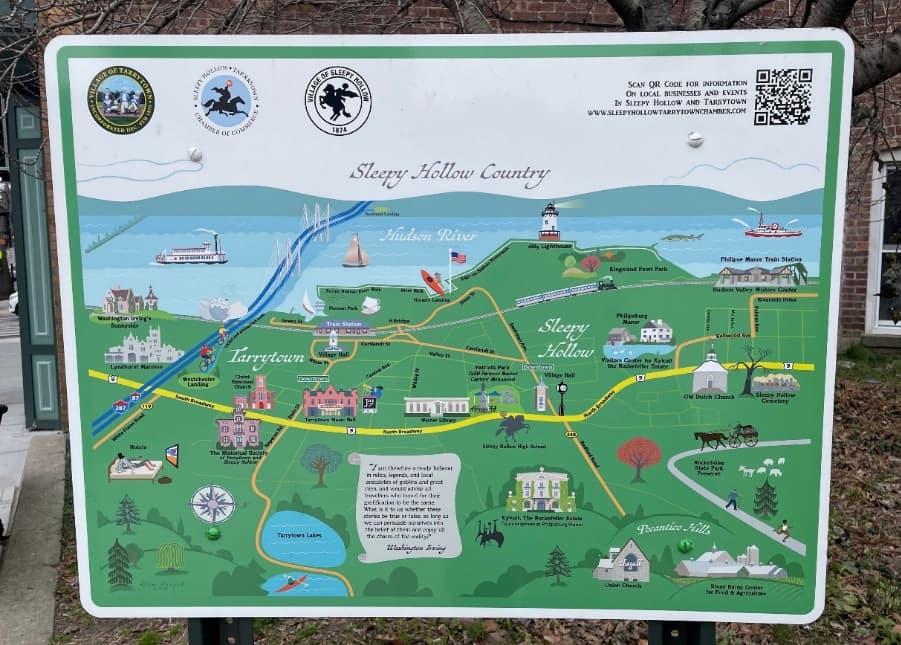
The Sleepy Hollow business district’s primary competitor is downtown Tarrytown, due to its proximity and entertainment offerings. Downtown Tarrytown offers a variety of restaurants, coffee shops, retail shops, art galleries, and music venues in a walkable downtown area less than one mile from the study area. These two commercial districts are similar in their size and location, but many visitors to the historic sites in Sleepy Hollow are drawn to Tarrytown’s active commercial corridor. Retail development at the Edge-on-Hudson could also potentially compete with the businesses in downtown Sleepy Hollow.
12 https://esd.ny.gov/sites/default/files/Hudson-Valley-2022-NYS-Tourism-Economic-Impact.pdf

The Downtown Sleepy Hollow Marketing Committee and SLR hosted two Business Owner Meetings to understand the challenges, opportunities, and ideas for supporting the study area business community. During these meetings, business owners within the study area voiced several concerns regarding the local business environment. Their primary concerns centered around parking availability, the current state of the physical environment, and several quality-oflife issues. Business owners believe that these issues contribute to the lack of foot traffic in the study area and the stagnant business growth. Business owners would like the Village of Sleepy Hollow to assist them with marketing and promoting their business as well as organizing more community events that help support small businesses. Business owners would also like to see the Village improve infrastructure, such as sidewalks, in the study area to create a more cohesive and attractive sense of place. The information gathered during these meetings and the existing conditions analysis were used to identify Sleepy Hollow’s strengths, weaknesses, opportunities, and threats, to develop the study area’s vision and recommendations, and to tailor the Marketing Workshops conducted as part of this study to best meet business owners’ needs. For a full summary of the Business Owner Meeting results, see Appendix C



Looking toward the future, it is important to build off the study area’s strengths and address its weaknesses. To succeed with this economic development effort, the Village must take advantage of its opportunities and act against potential threats. Table 7, SWOT, lists study area strengths, weaknesses, opportunities, and threats (SWOT) based on SLR’s observations and data collection, and feedback gathered from stakeholder engagement. The study’s recommendations will be centered around this SWOT analysis.
Table 7: SWOT
Strengths
Metro-North train access
Proximity to Tarrytown
Proximity to Edge-on-Hudson
History/Tourism
Loyal and supportive local customers
Cultural diversity
Opportunities
Expand the Latino businesses’ audience to non-Latinos and/or to growing Latino segment throughout Westchester.
Utilize NY Forward Grant Funds to improve study area streetscape and facades.
Attract customers with high spending potential from primary and secondary trade areas, including new Edge on Hudson residents
Weaknesses
Vacant properties
Retail selection and quality (lack of variety)
Non-cohesive building design
Parking availability and payment system
Community event coordination
Unkept building façades
Lack of pedestrian connection to train
Quality of life issues: noise, litter/garbage, nuisance behaviours
Lack of destination retail or entertainment
Threats
Tarrytown downtown competition
Edge-on-Hudson retail competition
High costs of materials and rent
Lack of progress/continued deterioration
The Village of Sleepy Hollow works in collaboration with local business owners and regional organizations to create a vibrant and charming downtown that attracts visitors from across Westchester County and the greater region with its culturally diverse and thriving business mix.

The existing conditions analysis revealed that the pedestrian connection from the Metro-North Tarrytown Train Station to the study area needs improvement. Business owners noted that the walk at night south on Cortlandt Street does not feel safe due to lack of lighting and the condition of the street; Businessownersalso noted a lack of convenient parking in the studyarea, especially for customers that are stopping to pick up takeout orders. Many business owners hope to expand their customer base to more Westchester County residents and Edge-on-Hudson residents, which will require improved access and pedestrian connections to downtown Sleepy Hollow. Some steps the Village can take to address these concerns and improve access to the study area include:
Enhance Pedestrian Connection to the Metro-North Tarrytown Train Station
The Village has been awarded NY Forward Funding for Cortlandt Street streetscape improvements. We suggest these funds be focused in the following areas:
Redesign the intersection of Cortlandt Street and Wildey Street, including adding trees, improving the crosswalks, adding pedestrian friendly lighting, and adding wayfinding signage that welcomes visitors to Sleepy Hollow and provides walking distances to different businesses or hubs within the study area.
Add landscaping at the intersection of Cortlandt Street and Wildey Street and along the 100 College Avenue parking lot on the east side of Cortlandt Street to enhance the pedestrian experience.
The Village should work with the Village of Tarrytown and/or the Sleepy Hollow Tarrytown Chamber of Commerce to develop collaborative wayfinding signage at the intersection of Cortlandt Street and Main Street in Tarrytown. The sign should guide visitors from the Metro-North Tarrytown Train Station to both Tarrytown and Sleepy Hollow and highlight key destinations in each.
o Improve Connections to Valley Street Businesses
The Village should consider enhancing the streetscape along North Washington Street to increase pedestrian access to the Valley Street plazas from Beekman Avenue. The Village should add street trees, clean building facades, improve sidewalks, and add pedestrian scale lighting.
The Village should work with business/building owners on North Washington Street to add vibrancy to the street through art. The Village should add a mural to the side façade of 60 Beekman Avenue or the north side (side facing Beekman Avenue) of 227 North Washington Street to enhance the pedestrian experience.
To attract visitors to the Valley Street Plazas from the south, the Village should develop a wayfinding strategy to direct pedestrians from Cortlandt Street across College Avenue or Depeyster Street to the Valley Street Plazas. The large apartment complexalong College Avenue allows for a continuoussidewalkmaking for a pedestrian friendly experience. The Village should add a crosswalk at the

intersection of Depeyster Street and Valley Street along Depeyster Street to allow for safer crossings and a more continuous pedestrian experience.
The Village, in partnership with property owners and business owners, should consider developing a shared parking strategy that utilizes under-capacity private lots. For example, the Santorini lot, located on Chestnut Street could be utilized for the Valley Street shopping plazas’ customers during off-peak restaurant hours.
The Village should develop a curbside management strategy to avoid double parking and to address business owners’ concerns regarding lack of parking for customers picking up takeout. Curbside management strategies seek to manage the competing demand of the various users of the curb. For the study area, use of the curb for commercial deliveries, customer pickup and parking, delivery-app drivers, on-street dining areas, pedestrians, and cyclists all need to be managed. We recommend creating flex zones based on the specific needs of businesses. Flex zones can be flexible in terms of allowing multiple uses, allowing different uses at different times of day, or allowing various uses along different portions of a street. The Village should consider the following options:
Assigning 15-minute, 1-hour, or 2-hr parking limits for on-street spaces in front of businesses. Because it would be a flex zone, the Village could designate most spaces as 1- or 2-hour parking but reserve a select few spots as 15-minute parking only.
Allow commercial loading directly in front of businesses only during certain hours, preferably hours that are less busy in terms of customer visits.
Designate commercial loading zones that are a short distance from businesses, such as just around the corner on a less busy street.
The Village should further study curb management issues in the study area either through field observation of curb usage and/or a survey of business owners regarding their preferences and needs.
Enhance Bicycle Infrastructure and Bicycle Connections to the Study Area
The Village should consider adding a bicycle lane along Beekman Avenue that connects the Edge-on-Hudson development to the study area. The Village should add other bicycle infrastructure, such as bike racks, near the Valley Street shopping plazas and the intersection of Beekman Avenue and Cortlandt Street.
The Village is working with the New York State Department of Transportation on the U.S. Route 9 Active Transportation Conceptual Plan (the Plan). The Plan has developed a conceptual design for Route 9 that adds bicycle lanes along Route 9 in the Village of Sleepy Hollow. The planned bicycle lanes create an opportunity for the Village to attract cyclists from the Route 9 lanes and the Old Croton Aqueduct Trail to the study area.
The Old Croton Aqueduct Trail runs through Sleepy Hollow and connects to the Empire State Trail, a 750-mile trail that connects New York City to the Canadian border. The Village should add signage at the intersection of

the Old Croton Aqueduct Trail and McKeel Avenue with distance to the bike repair shop and other attractions in the study area.
The Village should consider bicycle and pedestrian improvements at the intersection of Broadway/Route 9 and Beekman Avenue.
The Village should consider adding bicycle improvements and signage to attract cyclists heading southbound on Broadway/Route 9 down Pocantico Street to direct them to Beekman Avenue businesses.
Building façades in the study area need to be cleaned and several need repair. Business owners stated that their top concern about the future as a business owner in Sleepy Hollow is that downtown Sleepy Hollow will look the same in five years and continue to deteriorate. Business owners identified several attributes that add to Sleepy Hollow’ssense of place including itshistory, charm, natural beauty, and diversity. However, these attributes are often overshadowed by the vacant storefronts, unkept window displays, and building facades that require maintenance and cleaning. Some actions to enhance the study area’s aesthetics and create an attractive and cohesive sense of place include:
Repair Building Façades
Based on the findings of the physical conditions field survey, we recommend prioritizing façade improvements for the following buildings:
89 Cortlandt Street
128 Cortlandt Street
160 Cortlandt Street
185 Cortlandt Street
186 Cortlandt Street
72 and 74 Beekman Avenue
76 Beekman Avenue
205 Valley Street
174 Valley Street
99 College Avenue
232 North Washington Street
174 Cortlandt Street
Revise Commercial Signage Regulations
Amend Village signage regulations Chapter 338-6 to allow for more pedestrian friendly signage such as Blade Signs in the commercial districts. The Village should add specific design standards for these signs that are aligned with the character of the commercial districts.
Enhance the Design of the Valley Street Shopping Plazas
The Sleepy Hollow Plaza and Valley Plaza currently have mismatched design aesthetics that detract from the street’s character. The Plazas house many of Sleepy Hollow’s Latino businesses. The Village should consider working with the property owners and business owners to paint the buildings in a more cohesive color palate that emphasizes the cultural vibrancy of the businesses.

The Village should consider designating the Valley Street Plazas as a cultural district or quarter to help brand the plazas as a cultural destination. Some ideas include the “Valley Street Latin Quarter,” “Valley Street Latino Business District,” or “El Valle” The Village should gather input from the business owners regarding the name or designation.
We recommend adding signs welcoming visitors to the shopping area at the pedestrian island on Valley Street and North Washington Street, facing Beekman Avenue to help attract visitors to Valley Street.
We recommend adding a mural on the east side of the 185 Valley Plaza building (the façade facing the intersection of Chestnut and Valley Street), that builds off the already existing tile mosaic and reflects the cultures of the businesses in the area.
We recommend adding a welcome arch between 175 Valley Street and 174 Valley Street welcoming visitors to the district from the south.
Activate Vacant Storefronts with Art
While the ultimateobjective of anydowntown isto eliminatecommercial vacancies, vacant spaces can be temporarily enhanced through artistic window activations. Decorative window film, art installations, or marketing displays can reduce the blighting effect of vacancies and highlight potential uses for the vacant space. This solution would require the cooperation of property owners and would only be appropriate for vacant spaces that are in a state of good repair and safe to enter.13
Business owners shared that they have concerns about nuisance and illegal behavior in the Village that deters customers. Business owners mentioned behaviors such as drinking alcohol, smoking cannabis, playing loud music, public urination, and littering. Some of these behaviors are taking place on sidewalks while others are occurring on private property. Business owners also mentioned that residents will put up tables on the sidewalk to play dominoes and block the entrances to businesses. Some steps the Village can take to reduce or redirect these behaviors and reduce their impact on small businesses are:
Implement Crime Prevention through Environmental Design (CPTED)
CPTED is a set of strategies that uses the design of public spaces to prevent criminal or nuisance behavior. Strategies include property maintenance, delineation of private property, lighting, ensuring a clear line of sight, eliminating dark or hidden areas, landscaping, generating foot traffic at various times of day, and others. The main theory behind CPTED is that some environments are more likely to attract crime than others. Spaces that look poorly maintained, that are dark, and that provide hiding places can attract nuisance behavior; whereas well-
13 Regional Plan Association, Vacant Storefront Toolkit, 2023 https://rpa.org/work/reports/vacant-storefront-toolkit

lit, open spaces, that appear to be taken care of and frequently used, deter negative behavior.
The International Crime Prevention Through Environmental Design Association (ICA) provides free and paid resources on CPTED principals and strategies, including trainings for police officers and other public servants. The Village should consider investing in trainings and incorporating CPTED principles into planned streetscape improvements.
Facilitate Communication between the Sleepy Hollow Police Department and Business Owners
Continue to emphasize the importance of community policing and establishing relationships between the Police Department and the community.
Ensure the Police Department has culturally competent officers who can speak Spanish and/or train police officers on the use of mobile translation tools.
Invite the Chief of Police to Merchant’s Council meetings.
Consider a Local Law to Expand “No Smoking” Areas
Under NYS Law, smoking cannabis is allowed in most places where smoking tobacco is allowed, however municipalities can enact local laws that are stricter than NYS and Federal smoking regulations. The Village may consider the creation of a local law to prohibit smoking and vaping of both tobacco and cannabis in and/or within a reasonable distance of certain areas such as entrances and exits, outdoor seating at food service establishments, multi-unit common areas, service areas, and Village-owned properties.
Provide Appropriate Public Spaces for Outdoor Social Gatherings
Playing dominoes is a social activity that is important to many in various Latino communities, including the Dominican community, which is the largest Latino group in Sleepy Hollow Socialization in public spaces and practicing of cultural traditions is something the Village should encourage, as it adds to the vibrancy of the downtown. The Village should consider adding a designated public space for residents to play dominoes in the Plaza Nueva project (redesign of the park at WL Morse School) or in another public space in the study area. The Village should engage business owners and domino players in the design and creation of the public space and incorporate public art that reflects the cultures of the players.
The business mix in downtown Sleepy Hollow meets the residents’ needs with many neighborhood services, family restaurants, and low-price point retail stores. The study area is currently missing destination businesses, such as specialty boutiques, workout studios, and theaters, that attract consumers from surrounding communities that want a unique shopping or entertainment experience. There are currently 14 vacant commercial properties in the study area,

which provide an opportunity to improve the business mix downtown through targeted business attraction efforts. While attracting new businesses to fill vacancies is important, it is also important to support and maintain the existing businesses that provide affordable and culturally appropriate goods and services to Sleepy Hollow’s residents. We recommend the following actions to help promote a healthy business mix in the study area:
Utilize Vacant Storefronts on Beekman Avenue or Cortlandt Street as Pop-up Shop
Space
Pop-up shops provide opportunities for small businesses or entrepreneurs to test their business concepts in a brick-and-mortar location in a low-risk way. Pop-up shops often stay open for a few weeks to a few months. Currently, the highest concentration of vacancies in the study area is along Cortlandt Street and Beekman Avenue. Using the vacant storefronts on these streets as pop-up shops can help reactivate the vacant spaces and provide local entrepreneurs with the opportunity to test their business concepts. If these business concepts are successful, they could become long term tenants, helping to fill the vacant storefronts with businesses that have been proven to work. The Village, in partnership with the Westchester County business incubator or a business development non-profit should consider developing a program that works with property owners to provide their vacant storefronts for pop-up stores at an affordable cost and that provides grants and technical assistance to local entrepreneurs selected to start a pop-up shop.
The Village should work with local institutions who hold cultural events during the fall tourist season to activate vacant storefronts. The institutions could host readings, performances, and other cultural events in vacant storefronts. This will give space formore eventsand collaboration between culturalinstitutionsand local businesses. The cultural pop ups will also decrease the number of vacancies during peak tourist season, creating a more welcoming and economically thriving atmosphere for visitors.
Promote Available Commercial Properties in a Centralized Location
Consider creating a “Invest in Downtown Sleepy Hollow” webpage that consolidates various real estate listings for commercial properties downtown. The webpage could feature key facts about downtown Sleepy Hollow’s assets as a retail location. The webpage could be featured on the Sleepy Hollow Tarrytown Chamber of Commerce website.
Brand the Downtown as a Culinary Destination in Westchester County
The Village and Chamber of Commerce should consider developing a “Taste of Sleepy Hollow” guide that lists the food establishments in the study area and emphasizes the diversity of restaurants in the area.
The Village and Chamber of Commerce should explore hosting a Sleepy Hollow Restaurant Week at a time of year when tourism is slower, such as spring, summer, or winter.

Track Vacancies and Work Collaboratively with Property Owners to Fill Vacancies
This study includes a vacancy inventory. We recommend that the Village updates the vacancy inventory annually and reaches out to property owners to understand the barriers to filling vacancies. The vacant lot at 64-68 Beekman Avenue should be prioritized for redevelopment opportunities, as this is a large site in the center of Beekman Avenue with potential to catalyze economic activity in the downtown.
The Business Owner Meetings conducted during this study found that business owners were interested in accessing Village resources but found the systems of accessing the resources difficult and confusing. The Village wants business owners to take full advantage of the many resources the Village offers but struggles to raise awareness of the resources available to business owners. Lastly, business owners mentioned they would like the Village to host more local events that help support their businesses. The following recommendations will help build capacity and improve communication between business owners and the Village of Sleepy Hollow:
Re-establish the Sleepy Hollow Merchant’s Council
The Village, in partnership with the Sleepy Hollow Tarrytown Chamber of Commerce, should re-establish the Merchants Council. The Merchants Council provides merchants with a consistent and direct communication line with the Village, allowing merchants to communicate their concerns and ideas and allowing the Village to communicate important information and resources. It is important that this council has appropriate representation of business owners from the study area. As many of Sleepy Hollow’s business owners are non-native English speakers, language accommodations will be necessary to ensure proper representation.
Collaborate with Other Chambers of Commerce Organizations
The Sleepy Hollow Tarrytown Chamber of Commerce should coordinate their events with other Westchester County Chamber of Commerce organizations, such as the Rivertowns Chamber of Commerce and the Westchester Hispanic Chamber of Commerce.
Provide Easily Accessible Information Related to the Village’s Business Resources and Village’s Processes
The Village should create a webpage on the Village website that houses links to important business resources such as café seating permits, building permits, ribbon cutting event information, grants, and learning opportunities.
Simplify Permitting Processes for Sidewalk Café Seating
The Village should review their regulations for sidewalk café seating and streamline the application process for business owners. As of May 2024, the Village waived the sidewalk café permit fee and provided application forms to business owners at the Marketing Workshops.

Continue to Prioritize the Importance of the Community Liaison Position and Invest in Targeted Outreach to the Spanish-speaking Community and Other Business Owners who are Non-Native English Speakers
Most Sleepy Hollow business owners speak a language other than English as their native language, mainly Spanish. The Village hasmade a conscious effort to better serve the Spanish-speaking community through the creation of the Community Liaison position. Community Liaison Diana Loja is bilingual in Spanish and English and is an invaluable resource to the Village and to Sleepy Hollow’s business community. Throughout this study, Liaison Loja conducted personal outreach to business owners through door-to-door visits and calls. Liaison Loja’s work was essential to the success of the stakeholder outreach efforts. In addition, the SLR Team provided outreach materials, presentations, and resources in both Spanish and English, which allowed business owners to fully participate in meetings and workshops. All future efforts to engage the business community must be accessible to both English and Spanish speakers to ensure robust and equitable participation.

In addition to the established relationship with the Sleepy Hollow Tarrytown Chamber of Commerce, the Village should collaborate with local organizations and agencies to take advantage of existing programs and resources for business owners in Sleepy Hollow. The following organizations provide resources to business owners throughout Westchester:
o Westchester Hispanic Chamber of Commerce
o Westchester Multicultural Chamber of Commerce
o National Association for Latino Community Asset Builders
o The Catalyst—Westchester County Economic Development
o Element 46—Westchester County’s Startup Accelerator
o Rivertowns Chamber of Commerce
o The Women’s Enterprise Development Center
The Village, local organizations, or individual business owners may be eligible for the following funding sources that can advance downtown improvements and supportbusiness owners. Please note that several funding sources require the community to be a certified Pro-Housing Community by New York State Homes and Community Renewal (HCR). We understand that the Village is eligible for and pursuing Pro-Housing Community certification and we recommend that the Village prioritizes achieving this certification to maximize eligibility for future funding. Please note that the deadline to apply for Pro-Housing Community certification to be eligible for certain grants during the current round of NYS grant funding is July 31st, 2024.
NYS Small Business Revolving Loan Fund Round 2
The loan can be used for working capital, acquisition and/or improvement of real property (excluding passive investments in real estate), acquisition of machinery and equipment, and refinancing of debt obligations. Loans can either be microloans (between $500 and $25,000) or a regular loan (amount greater than $25,000 but no more than $20,000,000). Must be a business enterprise that is resident in and authorized to do business in New York State; independently owned and operated; not dominant in its field; and employs one hundred or fewer people on a full-time basis. Loan terms are based upon the Community Based Lending Organization’s offerings but may not exceed 10 years and interest rates are set by the lender.
Link: New York State Small Business Revolving Loan Fund Round 2
o The New York Forward Loan Fund 2
Connects small businesses and non-profits with working capital loans and business support services. Eligible businesses and nonprofits must have existing operations in NYS, 100 or fewer full-time employees, less than $5 million in gross

annual revenue, been in business for a least 1 year prior to application, demonstrated ability to repay loan through previous and projected cash flow. The loan can be used for equipment, payroll, utilities and rent, supplies, marketing, advertising, building renovations, and other expenses. The loan terms range from 36 and 72 months, up to $150,000, no prepayment penalties, no origination fees, and a fixed interest rate for the life of the loan. Applications are reviewed on a rolling basis. Applicants must pre-apply and, if qualified, will be matched to a community lender who will request additional documentation to determine if the business is ready for a loan and what terms are best suited to the business.
Link: New York Forward Loan Fund (nyloanfund.com)
New YorkState (NYS) Empire State Development(ESD) Capital Improvement Grants for Pro-Housing Communities Program: Up to $40 million
Supports capital improvement and placemaking projects located within ProHousing certified communities. Intended to foster economic development not only by being a catalyst to the increase in availability and access to housing, but also by stimulating community development neighborhood growth through placemaking projects and the elimination and redevelopment of blighted structures. Eligible applications include City, towns and villages that are certified by HCR as a ProHousing Community or applied to HCR to become a certified Pro-Housing Community by July 31, 2024, and be approved for certification prior to award announcements; and non-for-profit corporations and counties whose projects are located within a certified Pro-Housing Community. The minimum award is $100,000 and maximum award is $3 million. Grant amount will not be considered for more than fifty percent of the financing for any project based on the eligible total project cost. Because awards are offered as an incentive to undertake a project, the project cannot begin, and expenses cannot be incurred, before funding awards have been announced.
Link: Capital Improvements Grants for Pro-Housing Communities | Empire State Development (ny.gov)
NYS ESD Market New York: Up to $15 million
Market New York is a grant program established to strengthen tourism and attract visitors to New York State by promoting destinations, attractions, and special events. Funding is available for tourism marketing initiatives, capital/construction projects and the recruitment and/or execution of special events, including meetings, conferences, conventions, festivals, agritourism/craft beverage events, athletic competitions and consumer and industry trade shows. Eligible applicants include not-for profit corporations, municipalities, tourism promotional agencies, public benefit corporations and for-profit companies. Project categories include regional tourism marketing (working capital) and tourism capital (construction/renovation/capital costs). For Regional Tourism Marketing projects, the minimum grant amount is $50,000. Grant amount will not exceed 50 percent of the financing for tourism marketing projects. Project requires at least a 50 percent cash match of the total project cost. For Regional Tourism Capitalprojects, the minim grant amount is $150,000. Grant amount will not exceed more than 20

percent of the financing for the tourism capital projects. Project requires at least an 80 percent cash match.
Link: Market New York - Tourism Grant Program | Empire State Development (ny.gov)
NYS Department of State Local Waterfront Revitalization Program: Up to $13.975 million
The Department of State's Local Waterfront Revitalization Program (LWRP), funded under Title 11 of the Environmental Protection Fund (EPF), provides matching grants on a competitive basis for planning, design, and construction projects to revitalize communities and waterfronts. Eligible activities include preparing or updating a LWRP, preparing an LWRP component such as a Watershed Management Plan, or implementing an LWRP or a completed LWRP component. The minimum amount for the grant is $50,000 and the maximum is $2 million. The grant shall not exceed 75 percent of project costs or 85 percent of project costs if project is located in an environmental justice or disadvantaged community. Eligible applicants include villages, towns, or cities located along New York’s coasts or inland waterways, or a county with the written consent and acting on behalf of one or more eligible villages, towns, or cities.
Link: Local Waterfront Revitalization Program (24-LWRP-3) | Department of State (ny.gov)
In 2023, Sleepy Hollow completed its NY Forward Planning Process and recommended nine projects for the State to consider funding. On May 21, 2024, Governor Hochul announced that the NY Forward program has awarded the Village of Sleepy Hollow $4.5 million for the following projects:
Improve Streetscaping along Cortlandt Street
Project Description: Restore streetscape along Cortlandt Street with new sidewalks and crosswalks, drainage improvements, trees, lighting, new street furniture, and four EV charging stations.
Estimated Project Cost: $2,378,000
NYF Funding Award: $1,200,000
Institute a Façade Improvement Fund
Project Description: Establish a façade improvement fund that will enable business and property owners to improve their building facades in accordance with the Downtown Sleepy Hollow Façade Renovation Design Standards.
Project Cost: $390,000
NYF Funding Award: $300,000
Create “Plaza Nueva” and Redesign the Park at Morse School
Renovate the park at the Morse School to create a destination and a valuable resource for the community, including new play equipment and new seating area.
Project Cost: $1,221,000
NYF Funding Award: $1,000,000

Transform the Strand Theatre into a Community Arts and Culture Center
Renovate the Strand Theatre into a multi-purpose venue to showcase a diverse range of performers and artists. The Theatre will feature a studio space for localartists orarts groups, a gallery,and the future Sleepy Hollow Visitors Center.
Project Cost: $3,888,000
NYF Funding Award: $1,500,000
Construct Affordable Housing at 100 College Avenue
Develop underutilized property at 100 College Avenue with a transitoriented mixed-use affordable housing development.
Project Cost: $66,050,000
NYF Funding Award: $500,000
The following projects were submitted as part of the NY Forward application but were not selected for funding during this round. We suggest that the Village seeks out other grant opportunities to fund these projects:
Reimagine “Cortlandt Plaza”
Project description: Convert the current, temporary plaza on the west side of Cortlandt Street at Beekman Avenue into a permanent plaza by extending the curb to include existing traffic island, realign the roadway and install traffic calming measures, and add new street furniture and plantings. The project will also add decorative pavers or artwork to the Beekman Avenue roadbed.
Estimated Project Cost: $575,000
NYF Funding Request: $475,000
Revitalize Streetscaping along Valley Street
Project Description: Enhance the streetscape along Valley Street with new sidewalks and crosswalks, drainage improvements, trees, lighting, and new street furniture.
Project Cost: $1,052,000
NYF Funding Request: $726,000
Implement Branding, Marketing, and Wayfinding
Project Description: Createa branding and marketing strategy with physical and digital wayfinding signage with a focus on growing tourism and expanding the Village’s digital presence.
Project Cost: $260,000
NYF Funding Request: $240,000
Install Murals Across Downtown
Install a variety of murals across downtown, thereby beautifying the area and creating photo-worthy destinations for residents and visitors alike.
Project Cost: $225,000
NYF Funding Request: $225,00

o Westchester Magazine
Best of Westchester—encourage residents and visitors to nominate their favorite Sleepy Hollow Business
Westchester Wine and Food Festival
o Sleepy Hollow Tarrytown Chamber of Commerce Street Fair
o Sleepy Hollow Tarrytown Chamber of Commerce Winter Stroll
o Rivertowns Chamber of Commerce Taste Local
o TheStorefront.com—Website that Allows Property Owners to List Their Space for Daily Rent to Pop-Up Shops
o The International Crime Prevention through Environmental Design Association (ICA) EGuidebooks: https://www.cpted.net/E-guidebooks
o ITE Curbside Management Practitioners Guide (ite.org)
o See Appendix D for the Marketing Guide Shared with Business Owners at the Marketing Workshops



Village of Sleepy Hollow

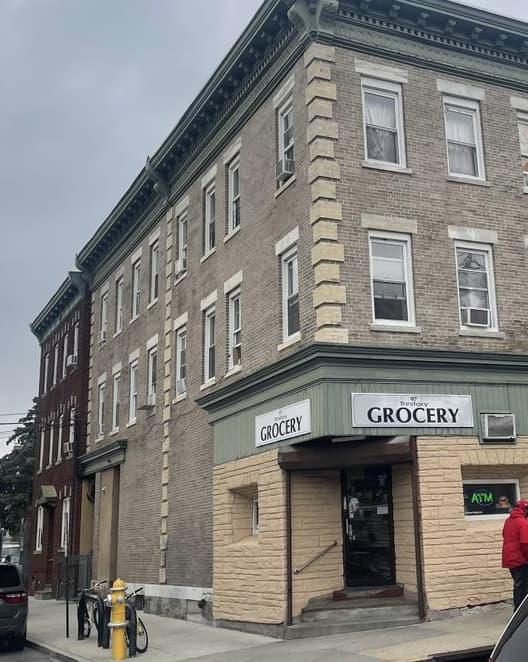
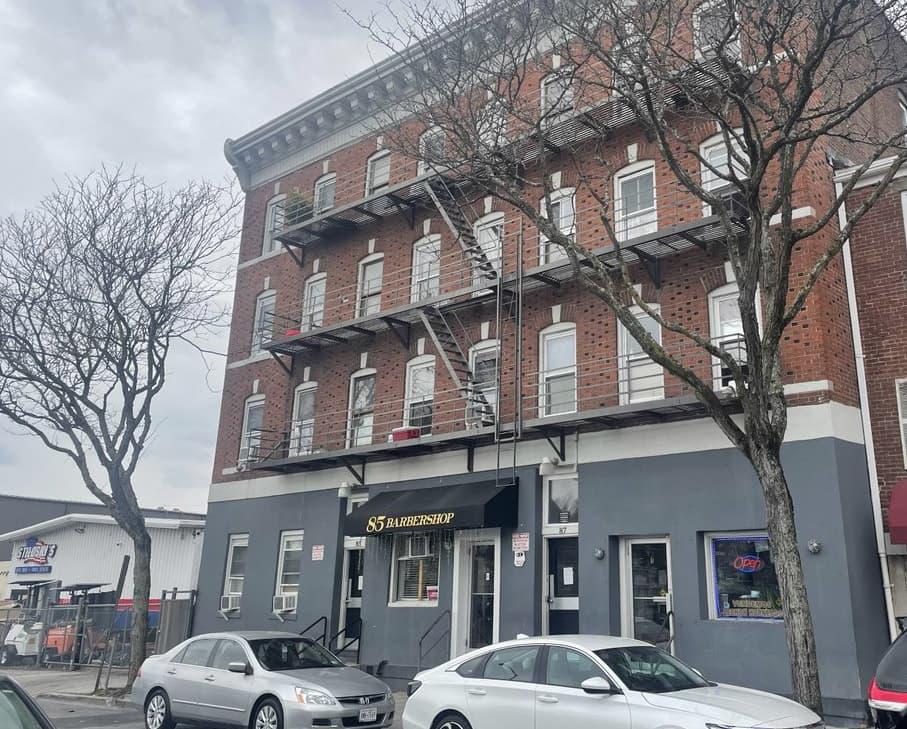

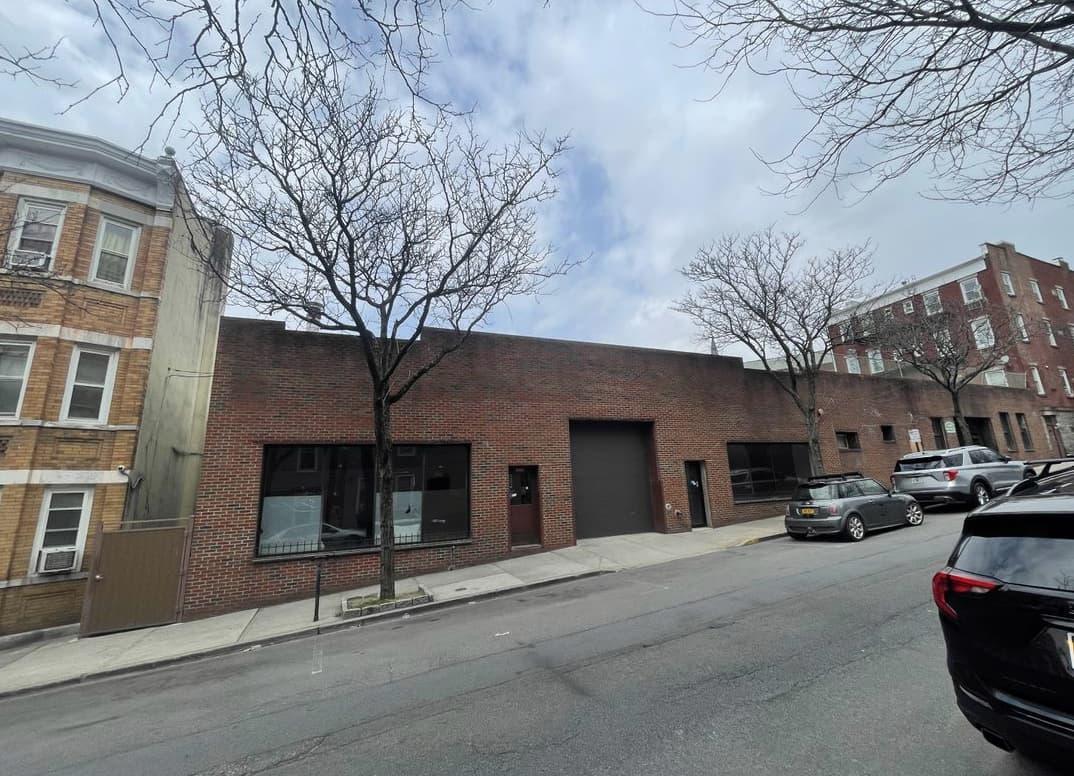


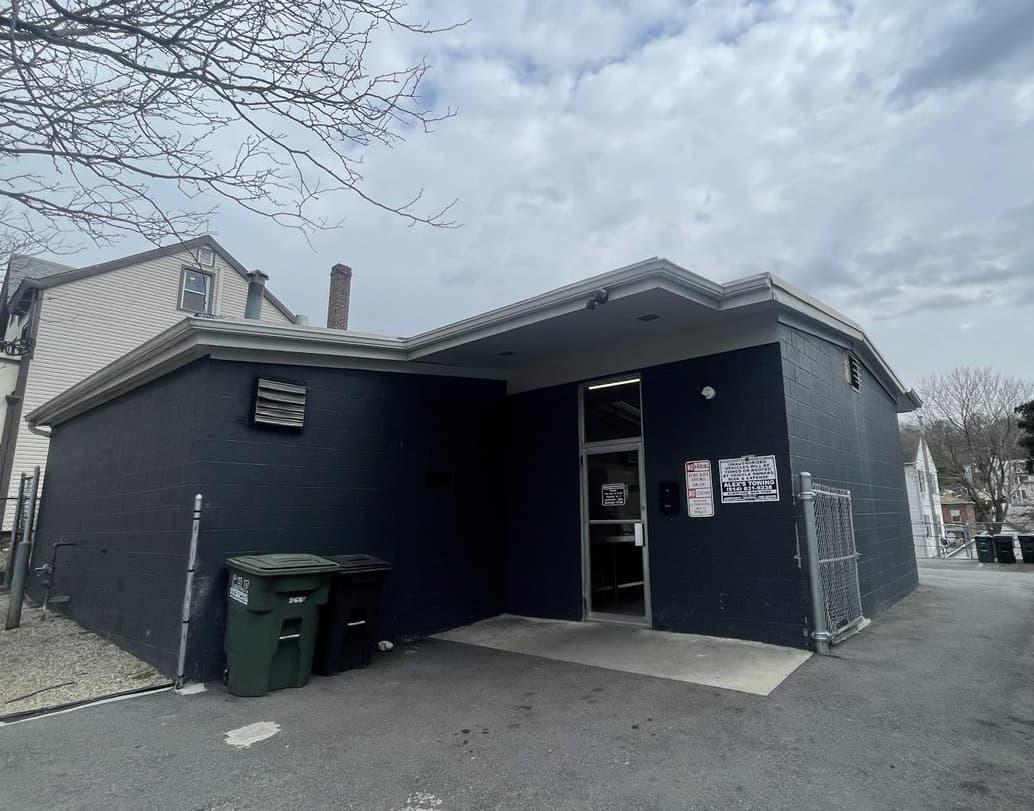


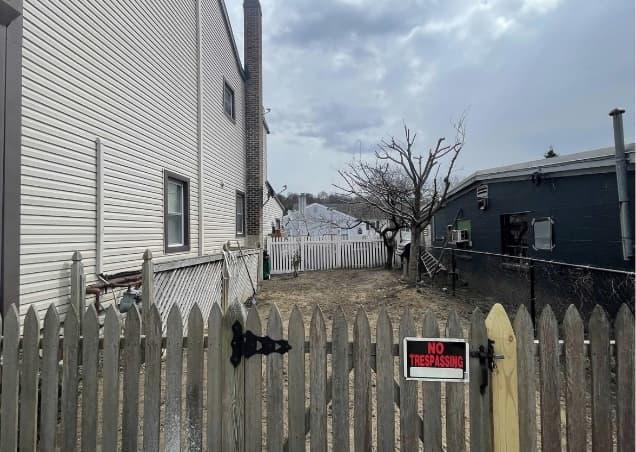
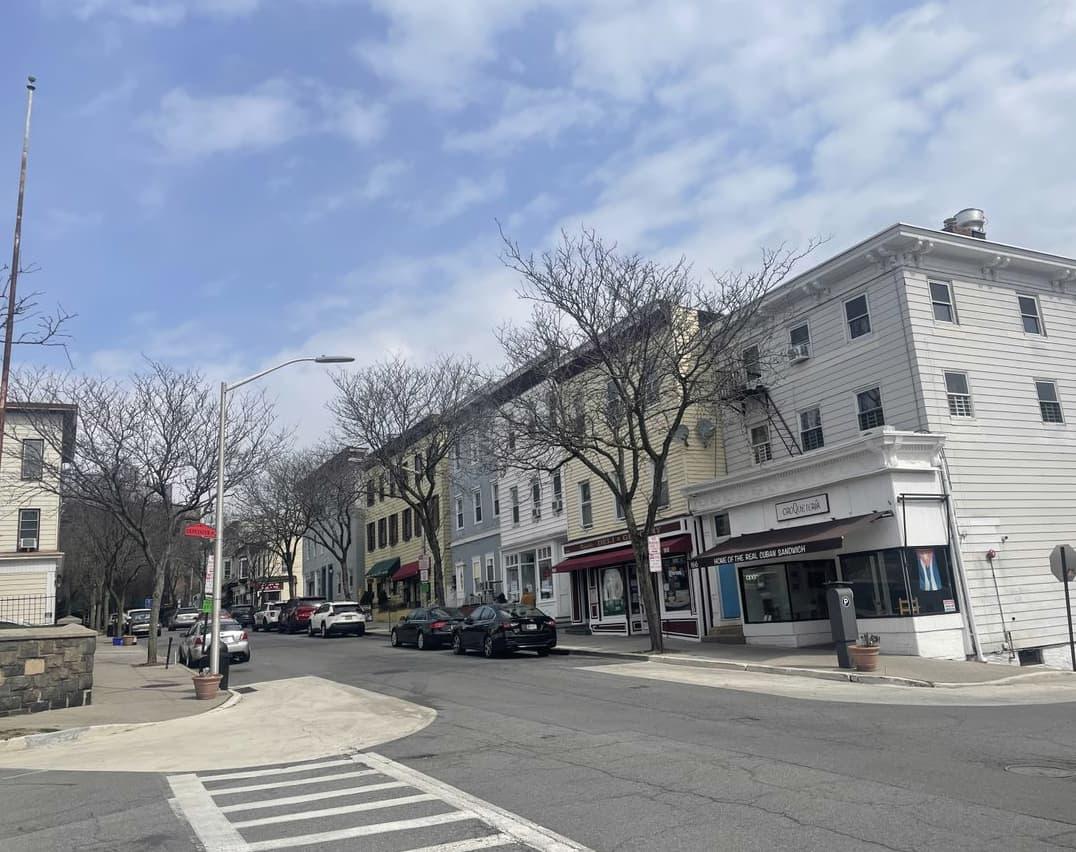


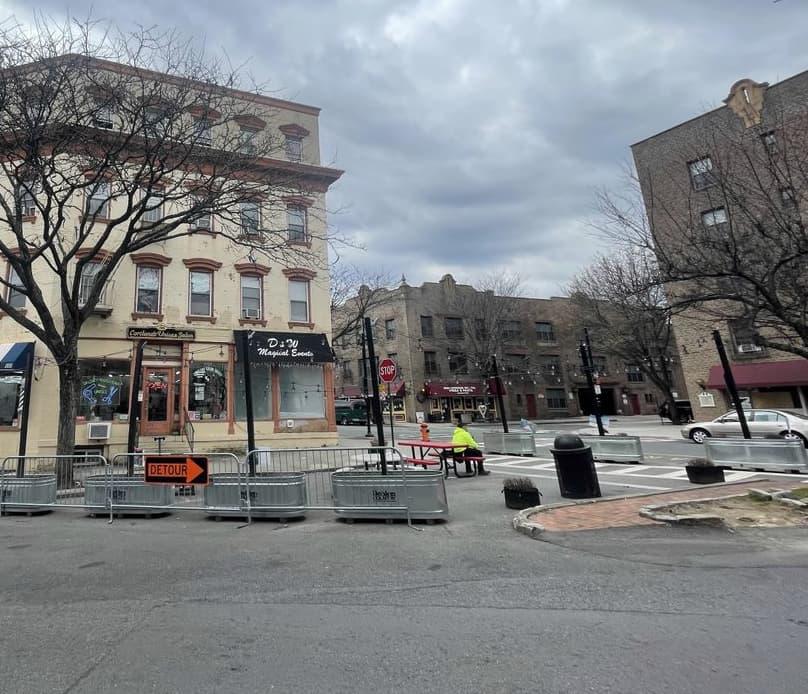
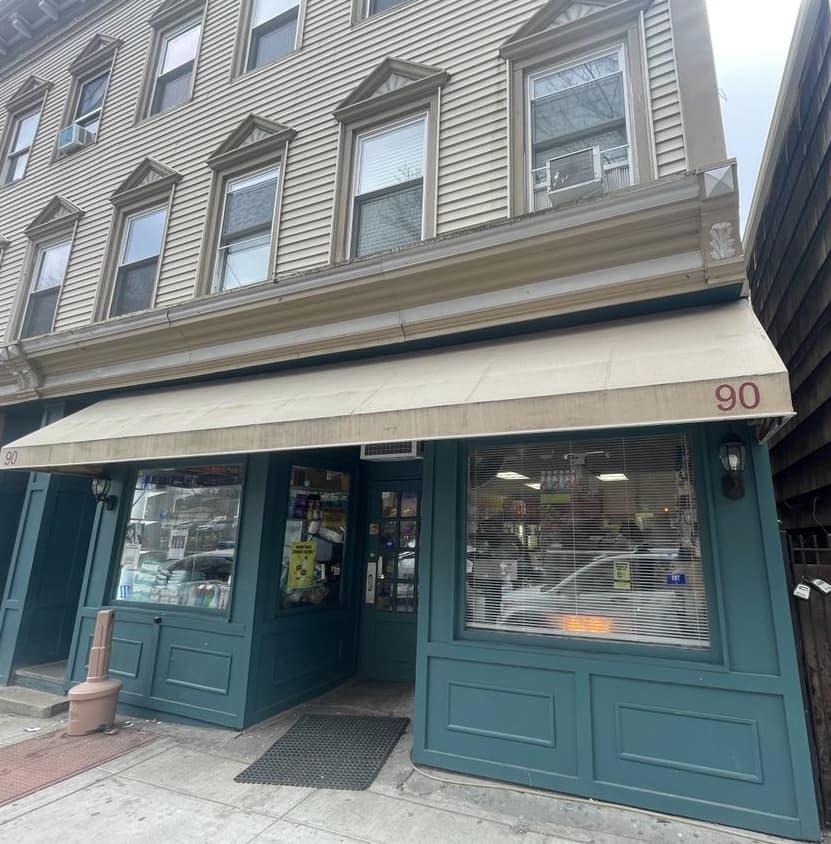

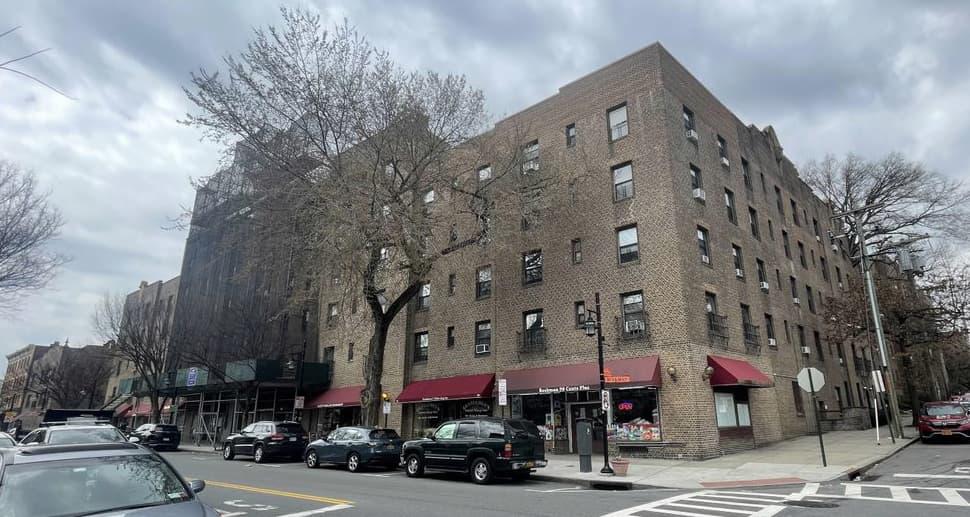
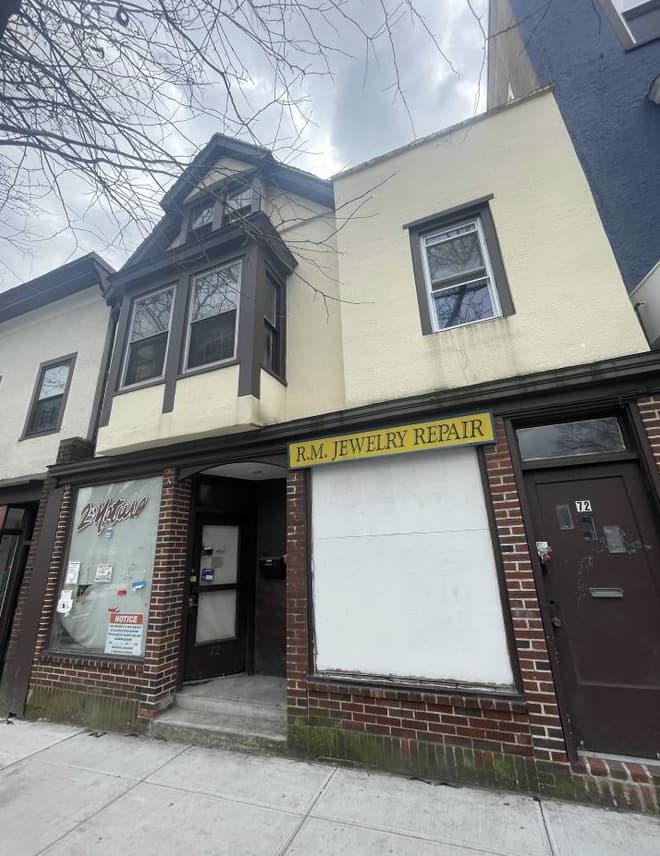






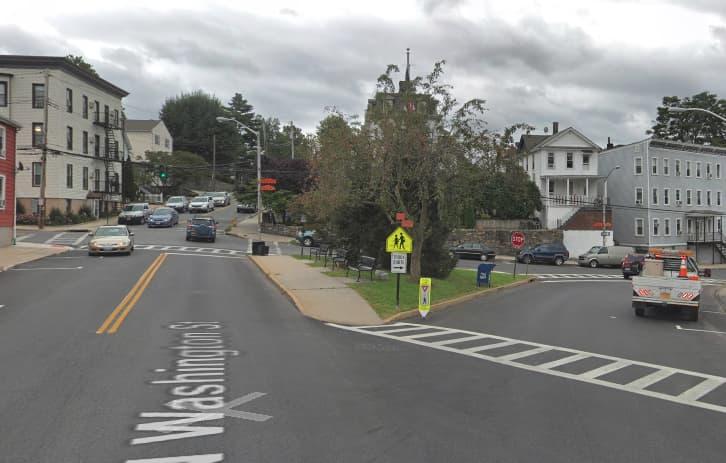
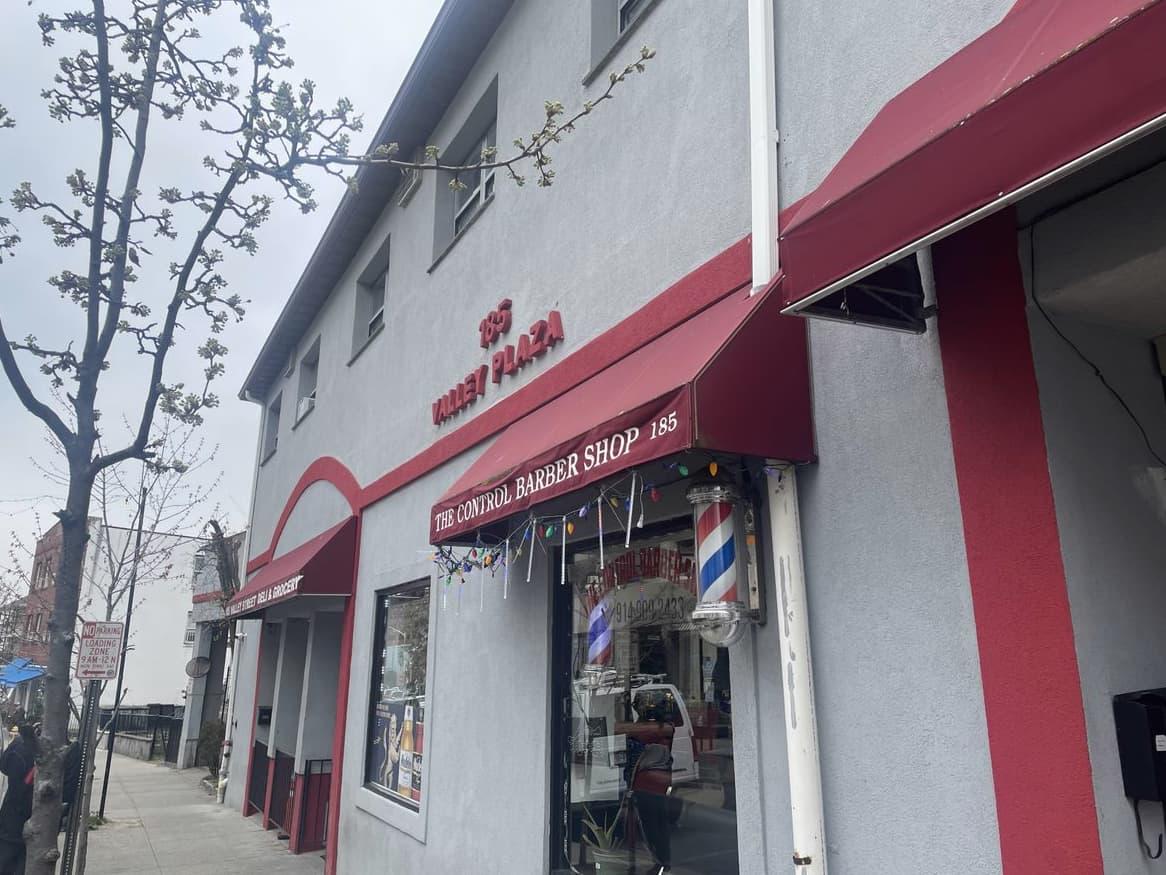

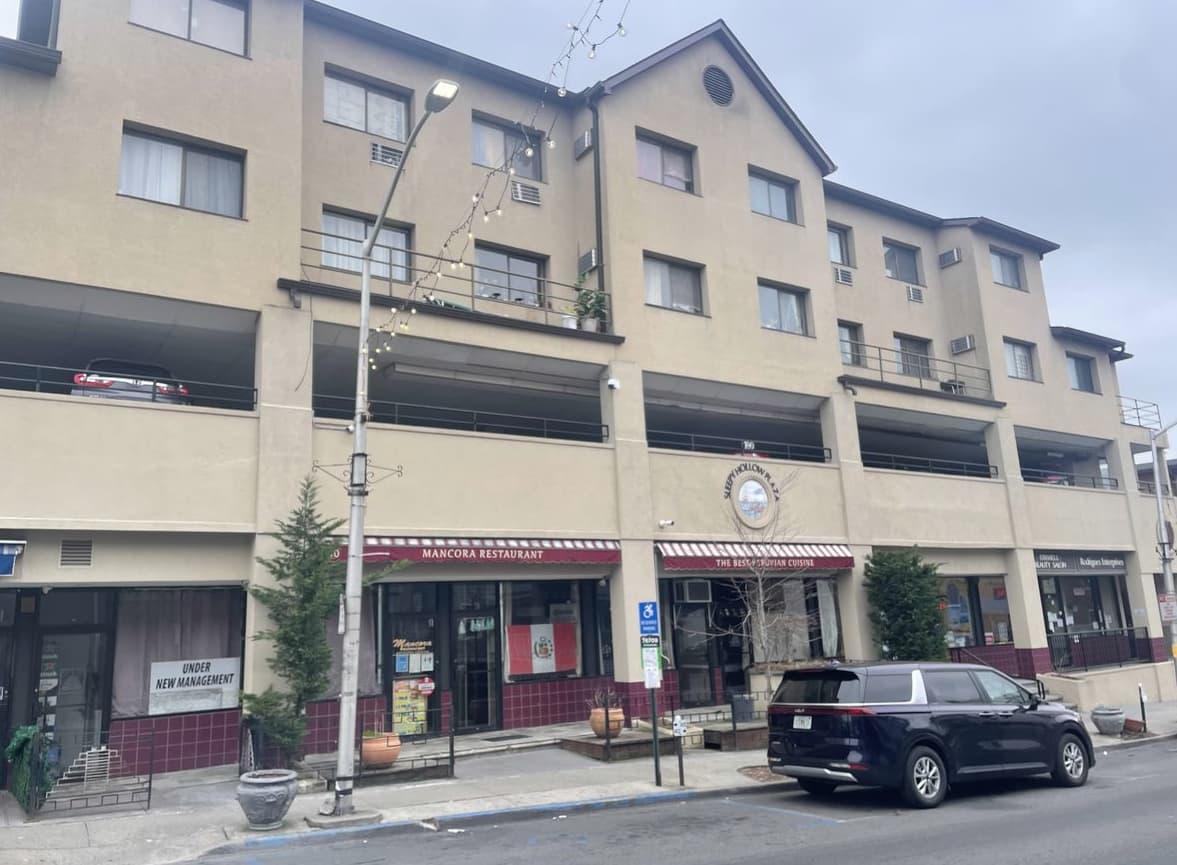



Village of Sleepy Hollow SLR Project No.: 141.21821.00001
May 31, 2024

BEEKMAN AVE
Hollow Bikes
95 BEEKMAN AVE Beekman 99 Cents Plus
Shops
Store 95 BEEKMAN AVE Gentlemen's Tailor Shop Inc
Shops 95 BEEKMAN AVE Sleepy Hollow Pharmacy inc
Related 95 BEEKMAN AVE Total Wireless Electronics Store
95 BEEKMAN AVE D&D Dental
Services 85 CORTLANDT ST 85 Barber Shop
87 CORTLANDT ST Gladys Market
Related 89 CORTLANDT ST Lourdes Hair and Beauty Salon Barber/Salon
91 CORTLANDT ST Gustito Dominicano Restarurant
Eating & Drinking
97 CORTLANDT ST La Cibaena Grocery Grocery Related
97 CORTLANDT ST M&M Barber Shop Unisex Barber/Salon 101 CORTLANDT ST Westco FG Corp Industrial (Other) 111 CORTLANDT ST Emely Food Corp. Grocery Related 128 CORTLANDT ST El Conquistador Eating & Drinking 128 CORTLANDT ST/ 99 COLLEGE AVE OJ Grocery & Deli
151 CORTLANDT ST Motronice Auto Repairs INC
Poultry
Grocery Related
Repair Shops
Laundry
Store 180 CORTLANDT ST Level Up Tarrytown Hair Salon
185 CORTLANDT ST Gyhr Barber Shop
185 CORTLANDT ST Cortlandt Salon Unisex
186 CORTLANDT ST Martha's Agency
Services
186A CORTLANDT ST La Esquina Del Sabor Restaurant Eating & Drinking

Address Business Name
188 CORTLANDT ST Two Sisters Beauty Salon
188 CORTLANDT ST Sleepy Hollow Nutrition
Barber/Salon
Eating & Drinking
190 CORTLANDT ST Spice of Life Variety Store
196 CORTLANDT ST Delgado's Deli Grocery
95 COLLEGE AVE La Esquina Latina Supermarket
100 COLLEGE AVE Tato Millz World
100 COLLEGE AVE SH Housing Associates
126 VALLEY ST North Tarrytown Housing Authority
147 VALLEY ST Closet Creations Inc.
147 VALLEY ST SunBlue Energy
174 VALLEY ST Religious of the Sacred Heart of Mary Life Center
175 VALLEY ST Santorini Greek Restaurant
Grocery Related
Grocery Related
Medical Services
Professional Services
Social Services
Professional Services
Professional Services
Social Services
Eating & Drinking
175 VALLEY ST Family Financial Check Cashing Cash Checking
180 VALLEY ST Mancora Restaurant
180 VALLEY ST Los Andes Bakery
180 VALLEY ST Erashell Beauty Salon
180 VALLEY ST William Simeoforides Architect
Eating & Drinking
Grocery Related
Barber/Salon
Professional Services
180 VALLEY ST Pacific Express SH Cash Checking
180 VALLEY ST Home Angelos Towne Craft Dealership (Herbalife)/Sichanutricion
185 VALLEY ST The Control Barber Shop
185 VALLEY ST El Troncaleno
Eating & Drinking
Barber/Salon
Eating & Drinking
185 VALLEY ST Tappanzee Deli Grocery Corp Grocery Related
205 VALLEY ST Tappan Car Wash Repair Shops
205 VALLEY ST Sleepy Hollow Laundromat Laundromat
228 N WASHINGTON ST Riverside Events Event Venue (Other)
230 N WASHINGTON ST 230 Latino Amigo Restaurant
Eating & Drinking
232 N WASHINGTON ST Ronald's Tailor Express Repair Shops
232 N WASHINGTON ST Mejia Financial Services
Financial Services
232 N WASHINGTON ST Sleepy Hollow Furniture Furniture (Other)



The Downtown Sleepy Hollow Market Study Team (Village Staff and SLR) hosted two Business Owner Meetings to understand the challenges, opportunities, and ideas for supporting the study area business community, and to register people for the merchant workshops that will be upcoming in April and May. The first Business Owner meeting, held on March 18, 2024 at 6pm, was specifically for Latino business owners and was facilitated in Spanish by Sleepy Hollow Community Liaison Diana Loja. The second Business Owner meeting, held on March 20, 2024 at 2pm, was facilitated in English by Julia Fiore of SLR; Spanish materials were available and Community Liaison Loja was available for interpretation needs. Both meetings included a brief presentation explaining the project goals, study area, and timeline; an engagement board activity; a survey; and a discussion. The business owner meetings attracted twenty-two Business Owners, with three Business Owners attending both meetings. Twenty-one Business Owners preregistered for the merchant workshops, and seventeen filled out the survey. Members of the Downtown Marketing Committee also attended the meetings, including René Léon, Lucia BallasTraynor, and Doug Lieb.
The information gathered during these two meetings will be used to identify Sleepy Hollow’s strengths, weakness, opportunities, and threats; tailor the merchant workshops to the business owner’s needs; and help guide the development of the study area’s vision and recommendations. The following sections provide an overview of the results from the various engagement activities.
To foster discussion and engage attendees who might not speak in a meeting setting, the team set up three boards with different questions on them. The first board asked participants “What are your three biggest challenges as business owners?” Participants identified their top three with dot stickers or if they wanted to add their own answer, they were able to write it down on a post-it note and attach it to the board. The other two boards asked open ended questions including, “What are your ideas to improve Beekman Avenue, Cortlandt Street, and Valley Street?” and “What are the benefits of having your business in Sleepy Hollow?” Attendees wrote their answers on post-it notes and attached them to the boards. The following sections provide an overview of the results, and a table including all entries can be found in Appendix C-1.



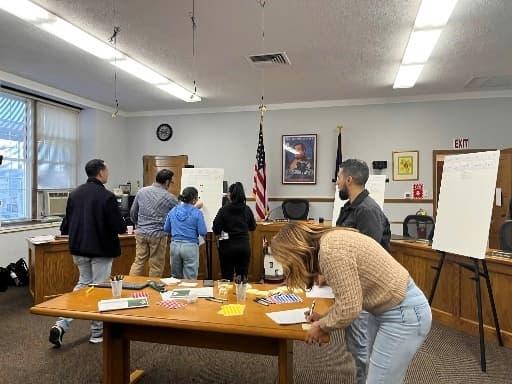



Participants from both meetings identified the high cost of materials as one of the biggest challenges they are currently facing as business owners. For the Latino Business Owner Meeting, the three challenges that received the most votes were: getting new customers, high rent costs, and high cost of materials. The three challenges that received the most votes at the General Business Owner Meeting were: lack of foot traffic, high costs of materials, and building

maintenance. The groups diverged regarding their ranking of “getting new customers” and “lack of foot traffic.” The Latino Business Owners identified getting new customers as their biggest challenge, while the attendees of the General Business Owner Meeting ranked this challenge last. The attendees of the General Business Owner Meeting ranked lack of foot traffic as their biggest challenge, while this challenge ranked second to last for the Latino Business Owners. Upon further discussion at the March 20th meeting, Business Owners shared that the lack of foot traffic is their biggest barrier to getting new customers.
3/18/2024 3/20/2024

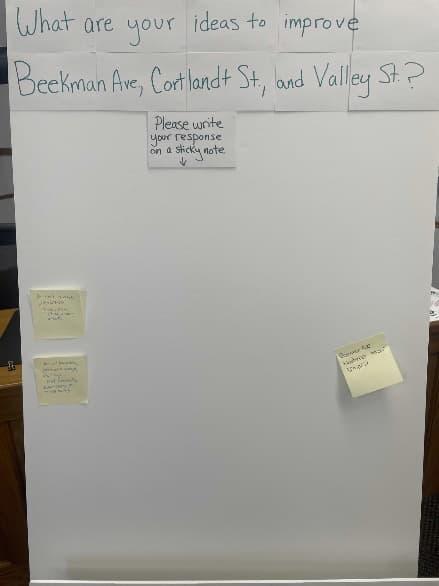

Most of the Business Owners’ ideas focused on the physical aspects of the streets, including parking, street cleaning, improving building facades, developing vacant lots, adding landscaping/plantings, and creating plazas. There was also mention of increasing security to prevent loitering and creating an easier process for applying for permits for outdoor dining.
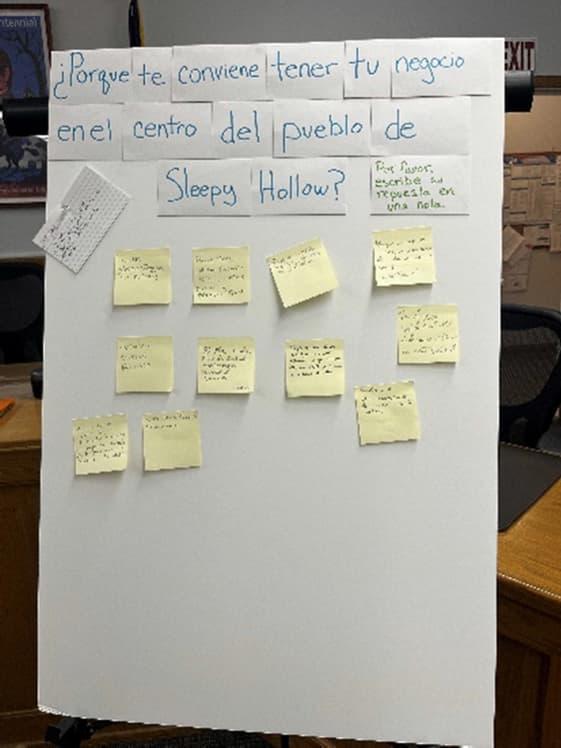

Many participants mentioned that the tourism industry and historic charm of Sleepy Hollow was a great benefit for the small business owners. Participants mentioned the loyal and supportive local customer base and the Latino Business Owners identified the large Latino population to be important to their success. Lastly, there was mention that the central location and variety of services in the area made it a convenient place to have a business.
During the meeting, a survey was handed out to all the attendees. The survey mirrored questions from the engagement board activity and had additional questions related to future concerns, how the Village can be of assistance, and questions about marketing efforts. The results are summarized in this memo and a full list of open-ended responses can be found in the appendix.
The main form of marketing that businesses in the study area use is social media. In conjunction with social media, 20 percent of businesses participate in community events to help market their business. Approximately 10 percent of businesses do not market their businesses and rely on word of mouth or other organic marketing strategies such as foot traffic.

What are you currently doing to market your
This question was also included in the engagement activity, but the survey results differ slightly from what was found through the engagement activity, due to many survey respondents selecting more than three challenges. Survey respondents indicated that the lack of foot traffic was the most common concern for business owners, followed by the high cost of materials, and getting new customers. High rent costs was in the top three in the engagement board activity, but rated below getting new customers in the survey.
What are your top 3 biggest challenges as a business owner?
Of the options provided in the survey, respondents are most concerned about rising costs and future economic conditions. Keeping up with technology was another concern commonly identified by the Business Owners. Business Owners also identified through write-in responses that they are concerned about the condition, appearance, and ambiance of Beekman Avenue and worry that it will remain in the same condition in the future.

Business Owners would like the Village of Sleepy Hollow to assist them with marketing and promoting their business as well as organizing more community events that help support small businesses. Business Owners would also like to see the Village improve infrastructure in the study area to create a more cohesive and attractive sense of place.
Participants’ ideas for improving downtown Sleepy Hollow included various infrastructure improvements including adding lighting, pedestrian crossings, parking, and improving sidewalk and building facades. The Business Owners also had ideas for dealing with the loitering by increasing security and addressing vacant buildings. Overall, participants believe that addressing the appearance and safety concerns of the downtown and activating it with more events and outdoor seating will help improve downtown Sleepy Hollow and make it a more attractive place for visitors, residents, and businesses.

Discussion at the Latino Business Owner Meeting allowed for further expansion and idea generation. The group identified the high cost of materials, high cost of rent, and fees on food delivery apps as financial challenges. They also identified several community challenges such as the noise from people playing music, teens loitering and smoking cannabis, drinking in the open, domino tables in the street, and littering. Lastly, the group mentioned the lack of parking and the difficult walk to the train station as physical condition challenges. The Business Owners would like the Village to bring back 15-minute parking, develop promotional material for visitors that highlights the location of all the businesses, increase activities during the tourist season, allow outdoor seating on sidewalks, fix sidewalk infrastructure, and increase enforcement to deter drug use and loitering. The Latino Business Owners noted a varied customer base of Latino and nonLatino customers; however, most were interested in expanding their non-Latino customer base. Currently, the most common way people hear about their businesses is through word of mouth or Instagram.
The Business Owners that attended the meeting identified the lack of visitor activities in Sleepy Hollow to be a large challenge as they generally direct visitors to Tarrytown or other surrounding towns. Business Owners also feel that the downtown needs more retail shopping options for visitors. The vacant properties and run down facades make it difficult to attract return visitors to Sleepy Hollow. Beekman Avenue Business Owners shared that they do not send their customers down Cortlandt or Valley Streets when they ask for directions to the train station because they do not think their customers will feel comfortable due to the rundown conditions of these streets. One business owner said they send their customers down North Washington Street instead. Similar to feedback gathered at the Latino Business Owner Meeting, the Business Owners identified loud music, loitering, drinking in the open, and littering to be a problem. There was consensus that their primary future concern is that Sleepy Hollow will look the same five years, with minimal physical improvements. Business Owners want the Village to focus on building maintenance, developing vacant properties, and creating a more attractive and safer streetscape for visitors and locals. Customers primarily come from within Sleepy Hollow, the Edge-on-Hudson, and New York City, but the Business Owners identified wanting to attract more customers from the surrounding communities in Westchester.
These two meetings revealed that Business Owners are proud to be a part of the history of Sleepy Hollow and enjoy the range of customers they serve but want the Village to be a more active and beautiful place that captivates visitors. Business Owners want the Village to improve the streetscape and building facades and to activate the downtown with more consistent events to create a safer and more attractive sense of place.

What are your ideas to improve Beekman Ave., Cortlandt St., and Valley St.?
More Parking.
Add more garbage cans and inform tenants about garbage collection days (some of the information is contradictory in places).
Permit for outdoor dining and add traffic light on corner.
More security on weekends.
Cortlandt Street should have a better view with more plants.
More parking area, pedestrian signage, and lighting and on Cortlandt Street.
It is good because it is Latin.
Need parking on Cortlandt Street.
More parking.
Make a nice plaza in the Washington Street and Valley Street triangle.
More police.
Sign directing people towards Valley St.
Keep the street clean and plant more flowers.
Need parking so that customers can park outside and wait for their food.
Develop vacant properties (the lot across from Morse school).
Clean up facades, window displays, awnings. Hold businesses, landlords, etc. to standards.
Keep Beekman Avenue cleaner.
What are the benefits of having your business in Sleepy Hollow?
Tourism, new projects (Edge-on-Hudson).
Because there is a large Latino population, and it is close to the train station.
Because it is a historic town, and we want to be a part of it.
Because it is a strategic point for commerce and for publicizing my food.
Tourists, diverse, beautiful.
The central location and variety of services are convenient for customers. Because of the Latino population that comes to the area.
Because the downtown is always the place of greatest affluence, and most roads lead you to the area.
Tourism helps attract new customers and makes Latino food well known.
Very quiet place and its mission is to impact the lives of people with unhealthy habits.
It is a very active town.
Two built-in months of seasonal business.
Sleepy Hollow tourist season.
Wonderful residents that are loyal/supportive.
The story of our business is embedded in Sleepy Hollow. A retired teacher from HS starts non-profit to hire her former students.
Tourism, history, charm, community support and involvement

Table 3: Survey Write-In Responses
What are your top 3 biggest challenges as business owners?
Lack of parking.
Problem with parking, I need a permit so clients can park outside to get their food. Parking.
Convincing people from across the county to come to Beekman. My big challenge is to find out if my business is a sustainable or a real business.
Table 4: Survey Write- In Responses
What is your top concern about the future as a business owner?
Condition/appearance/ambiance of Beekman.
Table 5: Survey Write-In Responses
What can the Village do to assist you as a small business owner?
More public events on Beekman Ave. Fill in empty storefronts and clean up downtown.
Table 6: Survey Responses
What are your ideas to improve downtown Sleepy Hollow?
Cortlandt Street need lighting, pedestrian crossings, and parking. Make the application easier to put tables outside the business. On Cortlandt St. there needs to be patrols and police in the area since there are many people in the area.
Address vacant buildings, encourage retail other than restaurants, clean up facades, have business maintain clean/neat window displays.
Extend events further to the west on Beekman Ave. and add parking. Cleaner streets, litter enforcement, better planned events in October. Improve sidewalks, have some picture points on the street (Instagram spots), improve siding, fine cars that are too loud and that do not stop at stop signs. Make sure no garbage is on the streets.



A checklist and guide to lay the groundwork for successful local marketing


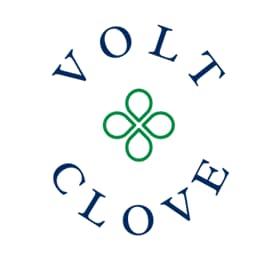


Ensure your business is discoverable online by being listed on popular mapping and social media platforms.

Why It's Needed: Many customers rely on online platforms to find and engage with local businesses.
Instructions:
1. Google My Business: Create and verify your business listing on Google My Business.
2. Yelp: Verify and optimize your business page on Yelp.
3. Social Media: Establish a presence on relevant social media platforms like Facebook, Instagram, Pinterest, TikTok and Twitter, even if you aren’t going to post on all accounts – you still need to reserve your pages.
a. Ensure all profile photos are consistent
b. All handles (@businessname) matches across every social media platform
c. Include your business information like hours open, website, where they can contact you, and physical address on each social media bio.
4. Ensure you are updating all social media bio’s when you have a business update
Brief Explanation: Own a unique domain name for your business website.



Why It's Needed: A custom domain name adds professionalism and credibility to your online presence.
Instructions:
1. Domain Registration: Register a domain name that reflects your business name or brand.
a. Common domain registration sites include: google, godaddy, namecheap.com
2. Hosting: Choose a reliable web hosting provider to host your website.
a. Common web hosting services include: Squarespace, Wix, and Shopify
b. If you choose Squarespace, know that Google is the best choice of domain providers as you can manage everything from the Squarespace platform.
Brief Explanation: Use an email address associated with your domain name for business communications.
i.e., name@yourbusiness.com
NOT: yourbusiness@yahoo.com
Why It's Needed: A domain email address looks more professional than generic email addresses (e.g., Gmail, Yahoo).
Instructions:


1. Email Hosting: Set up email hosting services through your web hosting provider.
2. Email Configuration: Configure email accounts using your domain name (e.g., info@yourbusiness.com).
Brief Explanation: Ensure your business page on Yelp is verified and up-to-date.

Why It's Needed: Yelp is a popular platform for consumers to read and leave reviews, influencing purchasing decisions. It also helps people discover your business that would not have otherwise.
As an aside, Yelp is more important to certain businesses like restaurants. People are more likely to use Yelp to find a restaurant than Google alone. Take advantage of all the free digital channels to increase your searchability, and therefore customer base as possible.
Instructions:
1. Verification Process: Follow Yelp's instructions to verify and claim ownership of your business page.
2. Profile Optimization: Complete your Yelp profile with accurate business information, photos, and contact details.
3. Paying for anything is completely up to you - Yelp will likely call you after you verify your business and try to sell you advertising space and additional advertising opportunities. This is not required to get visitors to your page on Yelp!


Brief Explanation: Verify and optimize your business listing on Google. This is a free service!

Why It's Needed: Google is a primary source of information for consumers searching for local businesses. This helps people find you particularly well on mobile devices. It is also a free service that helps local businesses tremendously with getting discovered. Instructions:
1. Google My Business: Claim and verify your business listing on Google My Business.
2. Profile Optimization: Provide accurate business information, photos, and updates to enhance visibility.
3. Note: Do not fall for scams. A common one is a person will call you “from Google” and suggest they can help you rank higher in Google, or that you aren’t visible in search. DO NOT AGREE TO PAY ANYTHING. Google listings have always been free.


Brief Explanation: Ensure your business is listed in local directories and Chamber of Commerce listings.


Why It's Needed: Local directories help potential customers find your business and improve local search engine rankings.
Instructions:
1. Chamber of Commerce: Contact the Sleepy Hollow local Chamber of Commerce to join and get listed in their directory. It costs $175 per year for a business with less than 10 employees to join the Chamber of Commerce.
2. Online Directories: Submit your business information to online directories.


Brief Explanation: Distribute your business menus to local lodging establishments and hotels if applicable.

Why It's Needed: Many travelers rely on hotel recommendations for dining options, presenting an opportunity to attract new customers. It’s worth noting that front desk and concierge services are your go-to partners in attracting tourists and business travelers. Instructions:
1. Menu Distribution: Contact local hotels and lodging establishments to provide them with your business menus. Send an email first, introducing your establishment, and find out the best time to make a visit to drop off some menus and details about your business.
2. Collaboration: Explore partnerships or collaborations with hotels for crosspromotion opportunities. Follow up with the contact(s) you made and let them know you appreciate their time. Ask if you can partner with them at a future event or conference.


Invest in attractive and visible signage for your business premises.
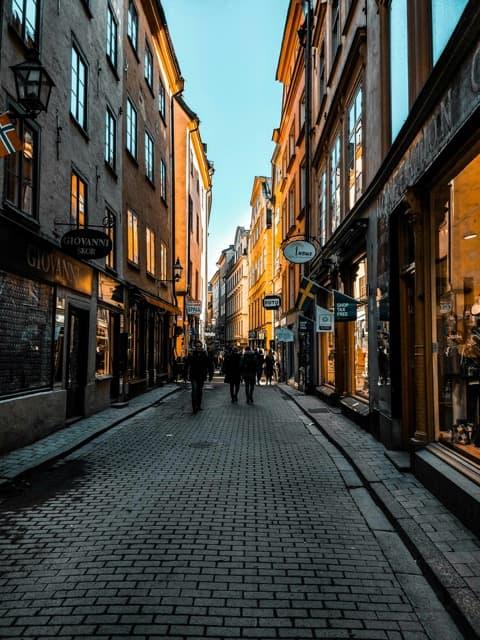
Why It's Needed: Physical signage helps attract foot traffic and reinforces brand identity. Main street businesses rely heavily on foot traffic. It’s best to captivate this audience with as much curb appeal as possible. Ensure attractive signage, keep the walkway clean, and invest in window displays that draw people inside your doors.
Instructions:
1. Design: Work with a professional designer to create eye-catching signage that reflects your brand. It’s worth investing in this part since it’s the first impression your business gives.
2. Placement: Ensure signage is prominently displayed and easily visible from the street or sidewalk.


Maintain a welcoming and visually appealing storefront.

Why It's Needed: First impressions matter, and a well-maintained storefront can attract potential customers. Clean doors, windows, and awnings regularly so that people want to step inside. If it’s the summertime, you may want to consider having water for people walking their dogs – anything extra you can anticipate to welcome potential customers is a good idea!
Instructions:
1. Exterior Maintenance: Regularly clean and maintain the exterior of your business premises.
2. Landscaping: Enhance curb appeal with landscaping, plants, or flower arrangements.
3. Extra touches are great as long as it makes sense for your business and is allowed by the Village.


Ensure your business operates according to its advertised hours of operation.

Why It's Needed: Consistency in operating hours builds trust and reliability with customers. Far too commonly do visitors come to an established business, only to be turned away by an unexpected closure. Closures sometimes happen – ensure you have a sign noting when you’ll be back!
Instructions:
1. Staff Scheduling: Plan and schedule staffing to accommodate advertised hours.
2. Communication: Update your website, social media, and physical signage promptly if there are any changes to operating hours.


Una lista de verificación y una guía para sentar las bases de un marketing local exitoso





Asegúrese de que su empresa sea visible en línea apareciendo en plataformas populares de mapas y redes sociales.

Por qué es necesario: muchos clientes confían en las plataformas en línea para encontrar empresas locales e interactuar con ellas.
Instrucciones:
1. Google My Business: cree y verifique su ficha de empresa en Google Mi Negocio.
2. Yelp: Verifique y optimice la página de su empresa en Yelp
3. Redes sociales: establezca una presencia en plataformas de redes sociales relevantes como Facebook, Instagram, Pinterest, TikTok y Twitter, incluso si no va a publicar en todas las cuentas, aún debe reservar sus páginas.
a. Asegúrese de que todas las fotos de perfil sean consistentes
b.Todos los identificadores (@businessname) coinciden en todas las plataformas de redes sociales
c. Incluya la información de su empresa, como el horario de atención, el sitio web donde pueden comunicarse con usted, la dirección física en la biografía de cada red social.
4. Asegúrese de actualizar todas las biografías de las redes sociales cuando tenga una actualización comercial.
Breve explicación: Sea propietario de un nombre de dominio único para el sitio web de su empresa.



Por qué es necesario: un nombre de dominio personalizado agrega profesionalismo y credibilidad a su presencia en línea. Instrucciones:
1. Registro de dominio: registre un nombre de dominio que refleje el nombre o la marca de su empresa.
a. Los sitios comunes de registro de dominios incluyen: google, godaddy, namecheap.com
2. Alojamiento: elija un proveedor de alojamiento web confiable para alojar su sitio web.
a. Los servicios de alojamiento web comunes incluyen: Squarespace, Wix y Shopify.
b. Si elige Squarespace, sepa que Google es la mejor opción de proveedores de dominio, ya que puede administrar todo desde la plataforma de Squarespace.
Breve explicación: utilice una dirección de correo electrónico asociada con su nombre de dominio para comunicaciones comerciales.
Es decir.nombre@tunegocio.com
NO:tunegocio@yahoo.com


Por qué es necesaria: una dirección de correo electrónico de dominio parece más profesional que las direcciones de correo electrónico genéricas (por ejemplo, Gmail, Yahoo).
Instrucciones:
1. Alojamiento de correo electrónico: configure servicios de alojamiento de correo electrónico a través de su proveedor de alojamiento web.
2. Configuración de correo electrónico: configure cuentas de correo electrónico utilizando su nombre de dominio (por ejemplo, info@yourbusiness.com).
Breve explicación: asegúrese de que la página de su empresa en Yelp esté verificada y actualizada.

Por qué es necesario: Yelp es una plataforma popular para que los consumidores lean y dejen reseñas, lo que influye en sus decisiones de compra. También ayuda a las personas a descubrir su negocio que de otra manera no habrían hecho.
Además, Yelp es más importante para determinadas empresas, como los restaurantes. Es más probable que las personas utilicen Yelp para encontrar un restaurante que Google solo. Aproveche todos los canales digitales gratuitos para aumentar su capacidad de búsqueda y, por lo tanto, su base de clientes al máximo.
Instrucciones:
1. Proceso de verificación: seguir Yelp instrucciones para verificar y reclamar la propiedad de su página comercial.


2. Optimización de perfil: complete su perfil de Yelp con información comercial, fotografías y datos de contacto precisos.
3. Pagar por cualquier cosa depende completamente de usted: es probable que Yelp lo llame después de que verifique su negocio e intente venderle espacio publicitario y oportunidades publicitarias adicionales. ¡Esto no es necesario para atraer visitantes a su página en Yelp!
Breve explicación: Verifique y optimice el listado de su empresa en Google. ¡Este es un servicio gratuito!

Por qué es necesario: Google es una fuente principal de información para los consumidores que buscan empresas locales. Esto ayuda a que las personas te encuentren especialmente bien en dispositivos móviles. También es un servicio gratuito que ayuda enormemente a las empresas locales a ser descubiertas.
Instrucciones:
1. Google My Business: reclama y verifica tu ficha de empresa en Google Mi Negocio.
2. Optimización de perfil: proporcione información comercial precisa, fotografías y actualizaciones para mejorar la visibilidad.
3. Nota: No caiga en estafas. Una situación común es que una persona te llame “desde Google” y te sugiera que puede ayudarte a obtener una clasificación más


alta en Google o que no eres visible en las búsquedas.NO ACEPTO PAGAR
NADA. Los listados de Google siempre han sido gratuitos.
Breve explicación: asegúrese de que su empresa aparezca en directorios locales y listados de la Cámara de Comercio.


Por qué es necesario: Los directorios locales ayudan a los clientes potenciales a encontrar su empresa y mejorar la clasificación en los motores de búsqueda locales. Instrucciones:
1. Cámara de Comercio: Contacto la Cámara de Comercio local de Sleepy Hollow para unirse y figurar en su directorio. A una empresa con menos de 10 empleados le cuesta 175 dólares al año unirse a la Cámara de Comercio.
2. Directorios en línea: envíe la información de su empresa a directorios en línea.


Menús proporcionados con alojamiento y hoteles locales.
Breve Explicación: Distribuir sus menús comerciales a establecimientos de hospedaje y hoteles locales si corresponde.

Por qué es necesario: muchos viajeros confían en las recomendaciones de hoteles para elegir opciones gastronómicas, lo que presenta una oportunidad para atraer nuevos clientes. Vale la pena señalar que los servicios de recepción y conserjería son sus socios preferidos para atraer turistas y viajeros de negocios. Instrucciones:
1. Distribución de Menús: Contacta con hoteles y establecimientos de hospedaje locales para facilitarles tus menús comerciales. Envíe primero un correo electrónico, presentando su establecimiento y averigüe el mejor momento para realizar una visita y dejar algunos menús y detalles sobre su negocio.
2. Colaboración: explorar asociaciones o colaboraciones con hoteles para oportunidades de promoción cruzada. Haga un seguimiento de los contactos que realizó y hágales saber que aprecia su tiempo. Pregunte si puede asociarse con ellos en un evento o conferencia futuro.


Invierte en una señalización atractiva y visible para tu local comercial.

Por qué es necesaria: la señalización física ayuda a atraer tráfico peatonal y refuerza la identidad de la marca. Los negocios de las calles principales dependen en gran medida del tráfico peatonal. Lo mejor es cautivar a esta audiencia con el mayor atractivo posible. Garantice una señalización atractiva, mantenga el pasillo limpio e invierta en escaparates que atraigan a la gente al interior de sus puertas.
Instrucciones:
1. Diseño: trabaje con un diseñador profesional para crear carteles llamativos que reflejen su marca. Vale la pena invertir en esta parte ya que es la primera impresión que da tu negocio.


2. Ubicación: Asegúrese de que la señalización esté en un lugar destacado y fácilmente visible desde la calle o la acera.
Mantenga un escaparate acogedor y visualmente atractivo.

Por qué es necesario: las primeras impresiones son importantes y un escaparate bien mantenido puede atraer clientes potenciales. Limpie puertas, ventanas y toldos con regularidad para que la gente quiera entrar. Si es verano, quizás quieras considerar tener agua para las personas que pasean a sus perros; ¡cualquier cosa adicional que puedas anticipar para dar la bienvenida a clientes potenciales es una buena idea!
Instrucciones:
1. Mantenimiento exterior: Limpie y mantenga periódicamente el exterior de su local comercial.
2. Paisajismo: Mejore el atractivo exterior con paisajismo, plantas o arreglos florales.
3. Los toques adicionales son excelentes siempre que tengan sentido para su negocio y estén permitidos por el Village.


Asegúrese de que su empresa funcione de acuerdo con el horario de atención anunciado.

Por qué es necesario: La coherencia en el horario de atención genera confianza y confiabilidad con los clientes. Con mucha frecuencia, los visitantes llegan a un negocio establecido y son rechazados por un cierre inesperado. A veces se producen cierres: ¡asegúrese de tener un cartel que indique cuándo volverá!
Instrucciones:
1. Programación de personal: planifique y programe la dotación de personal para adaptarse a las horas anunciadas.
2. Comunicación: actualice su sitio web, redes sociales y señalización física de inmediato si hay algún cambio en el horario de atención.









